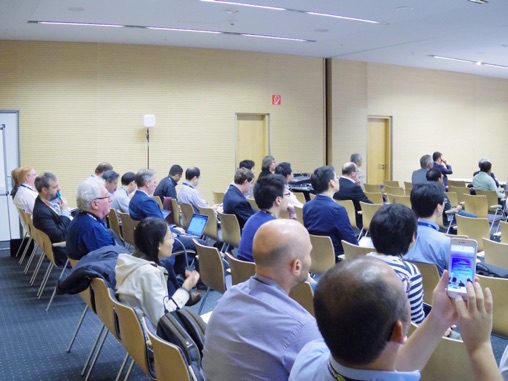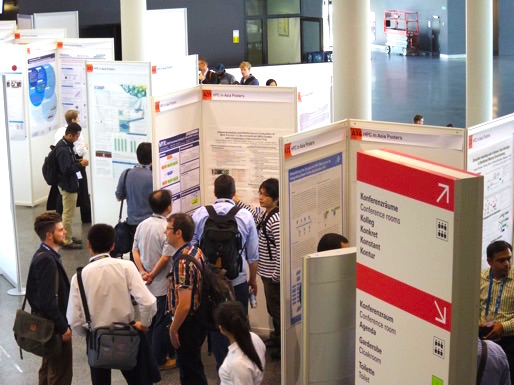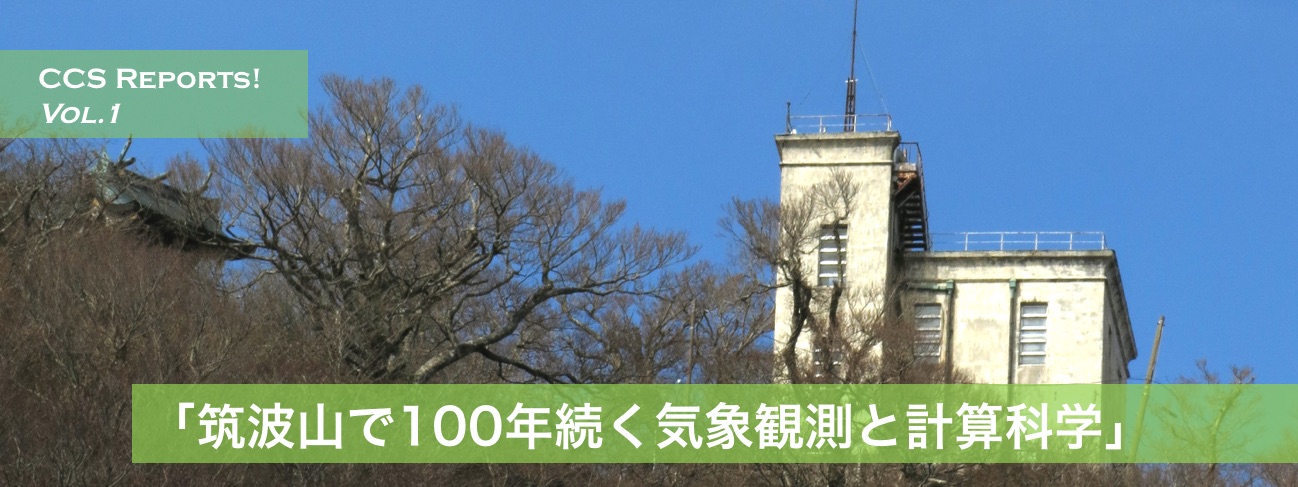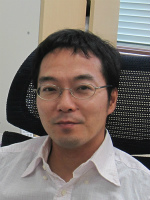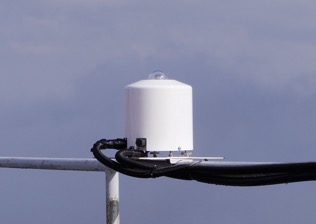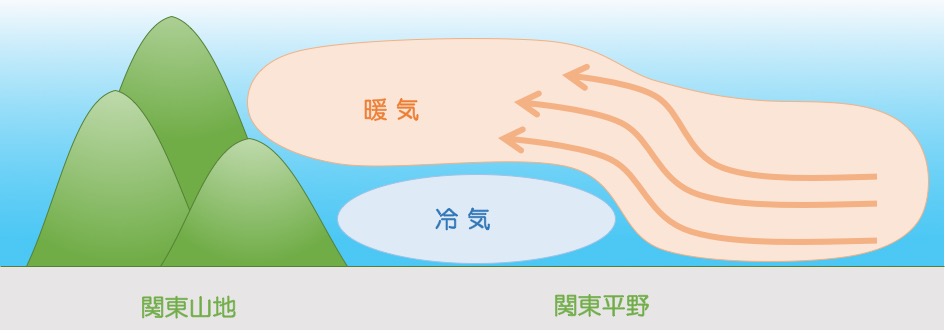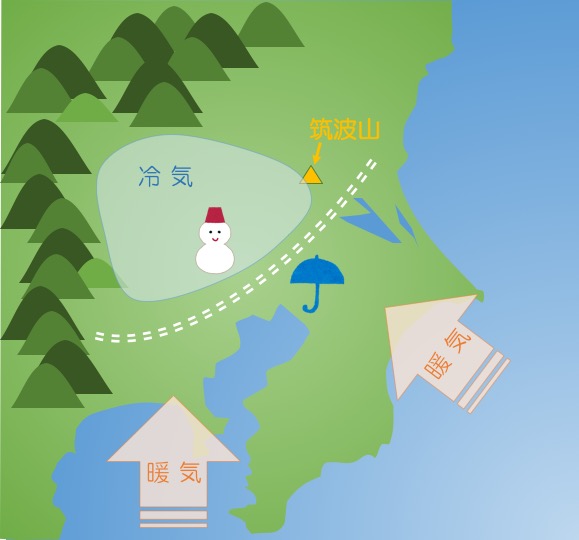素粒子物理研究部門
宇宙・原子核物理研究部門 宇宙分野 / 原子核分野
量子物性研究部門
生命科学研究部門 生命機能情報分野 / 分子進化分野
地球環境研究部門
高性能計算システム研究部門
計算情報学研究部門 データ基盤分野 / 計算メディア分野
素粒子物理研究部門
研究論文
査読付き論文
1. Y. Nakamura, K.-I. Ishikawa, Y. Kuramashi, T. Sakurai, H. Tadano, Modified block BiCGSTAB for lattice QCD, Comp. Phys. Commun. 183, No.1 (2012) 34-37
2. PACS-CS Collaboration: S. Aoki, K.-I. Ishikawa, N. Ishizuka, K. Kanaya, Y. Kuramashi, Y. Nakamura, Y. Namekawa, M. Okawa, Y. Taniguchi, A. Ukawa, N. Ukita, and T. Yoshie, 1+1+1 flavor QCD+QED simulation at the physical point, Phys. Rev. D 86, No.3 (2012) ref.034507, pp.1-6
3. PACS-CS Collaboration: Y. Namekawa, S. Aoki, K.-I. Ishikawa, N. Ishizuka, K. Kanaya, Y. Kuramashi, M. Okawa, Y. Taniguchi, A. Ukawa, N. Ukita, T. Yoshie, Charmed baryons at the physical point in 2+1 flavor lattice QCD, arXiv:1301.4743
4. T. Yamazaki, K.-I. Ishikawa, Y. Kuramashi, and A. Ukawa, Helium nuclei, deuteron, and dineutron in 2+1 Flavor lattice QCD, Phys. Rev. D 86, No.7 (2012) ref.074514, pp.1-9
5. Sinya Aoki, Takumi Doi, Tetsuo Hatsuda, Yoichi Ikeda, Takashi Inoue, Noriyoshi Ishii, Keiko Murano, Hidekatsu Nemura, Kenji Sasaki (HAL QCD Collaboration), Lattice QCD approach to Nuclear Physics, Prog. Theor. Exp. Phys. 2012, No.1 (2012) ref.01A105, pp.1-38
6. Sinya Aoki, Janos Balog, Peter Weisz, Toward an understanding of short distance repulsions among baryons in QCD – NBS wave functions and operator product expansion – , Prog. Theor. Phys. 128, No.6 (2012) 1269-1282
7. S. Aoki, J. Balog, T. Doi, T. Inoue, P.Weisz, Short Distance Repulsion Among Baryons, Int. J. Mod. Phys. E22, No.5 (2013) ref.1330012, pp.1-16
8. Sinya Aoki, Bruno Charron, Takumi Doi, Tetsuo Hatsuda, Takashi Inoue, Noriyoshi Ishii, Construction of energy-independent potentials above inelastic thresholds in quantum field theories, Phys. Rev. D87, No.3 (2013) ref.34512, pp.1-10
9. N. Ishii, S. Aoki, T. Doi, T. Hatsuda, Y. Ikeda, T. Inoue, K. Murano, H. Nemura and K. Sasaki (HAL QCD Collaboration), Hadron-Hadron Interactions from Imaginary-time Nambu-Bethe-Salpeter Wave Function on the Lattice, Phys. Lett. B712 (2012) 437-441
10. Shinji Ejiri, Kazuyuki Kanaya, and Takashi Umeda, for the WHOT-QCD Collaboration, Ab initio study of the thermodynamics of quantum chromodynamics on the lattice at zero and finite densities, Prog. Theor. Exp. Phys. 2012, No.1 (2012) ref.01A104, pp.1-35
11. T. Umeda, S. Aoki, S. Ejiri, T. Hatsuda, K. Kanaya, Y. Maezawa, H. Ohno (WHOT-QCD Collaboration), Equation of state in 2 + 1 flavor QCD with improved Wilson quarks by the fixed scale approach, Phys. Rev. D 85, No.9 (2012) ref.094508, pp.1-11
12. Y. Maezawa, T. Umeda, S. Aoki, S. Ejiri, T. Hatsuda, K. Kanaya and H. Ohno (WHOT-QCD Collaboration), Application of fixed scale approach to static quark free energies in quenched and 2 + 1 flavor lattice QCD with improved Wilson quark action, Prog. Theor. Phys. 128, No.5 (2012) 955-970
13. S. Ejiri, S. Aoki, T. Hatsuda, K. Kanaya, Y. Nakagawa, H. Ohno, H. Saito, T. Umeda (WHOT-QCD Collaboration), Numerical study of QCD phase diagram at high temperature and density by a histogram method, Cent. Eur. J. Phys. 10, No.6 (2012) 1322-1325
14. Shinji Takeda, Yoshinobu Kuramashi, and Akira Ukawa, Phase of quark determinant in lattice QCD with finite chemical potential, Phys. Rev. D85 No.9 (2012) ref.096008, pp.1-12
15. S. Aoki, H. Fukaya and Y. Taniguchi, Chiral symmetry restoration, the eigenvalue density of the Dirac operator, and the axial U(1) anomaly at finite temperature, Phys. Rev. D 86, No.11 (2012) ref.114512, pp.1-18.
16. K.-I. Ishikawa, Y. Iwasaki, Yu Nakayama and T. Yoshie, Conformal theories with an infrared cutoff, Phys. Rev. D87, No.7 (2013) ref.071503(R), pp.1-5
査読無し論文
1. Y. Namekawa for PACS-CS collaboration, Charmed baryon spectroscopy on the physical point in 2+1 flavor lattice QCD, PoS (LATTICE 2012) (2012) ref.139, pp.1-7
2. Y. Taniguchi, Non-perturbative evaluation of cSW for smeared link clover fermion with Iwasaki gauge action, PoS (LATTICE 2012) (2012) ref.236, pp.1-7
3. N. Ishii for HAL QCD Collaboration, 2+1 flavor QCD result of nuclear forces, Proceedings of the 20th International IUPAP Conference on Few-Body Problems in Physics, Few-Body Systems in press
4. N. Ishii for HAL QCD Collaboration, Baryon-baryon Interactions from Lattice QCD, PoS (CD12) ref.025, to be appeared
5. H. Nemura for HAL QCD Collaboration, Lambda N and Sigma N interactions from lattice QCD, Proceedings of the 20th International IUPAP Conference on Few-Body Problems in Physics, Few-Body Systems in press
6. H. Nemura for HAL QCD Collaboration, Lattice calculation of baryon-baryon interaction and few-body systems, Proceedings of the International Workshop on Strangeness Nuclear Physics, to be published in Genshikaku Kenkyu Suppl.
7. K. Sasaki for HAL QCD Collaboration, Quark mass dependence of hyperonic interactions from lattice QCD, PoS (LATTICE 2012) (2012) ref.157, pp.1-7
8. K. Sasaki for HAL QCD Collaboration, Coupled channel approach to S-wave hyperonic interactions from lattice QCD, Proceedings of the 20th International IUPAP Conference on Few-Body Problems in Physics, Few-Body Systems in press
9. T. Umeda, S. Aoki, S. Ejiri, T. Hatsuda, K. Kanaya, Y. Maezawa, H. Ohno (WHOT-QCD Collaboration), Thermodynamics in 2 + 1 flavor QCD with improved Wilson quarks by the fixed scale approach, PoS (LATTICE 2012) (2012) ref.074, pp.1-7
10. S. Ejiri, Y. Nakagawa, S. Aoki, K. Kanaya, H. Saito, T. Hatsuda, H. Ohno, T. Umeda (WHOT-QCD collaboration), Probability distribution functions in the finite density lattice QCD, PoS (LATTICE 2012) (2012) ref.089, pp.1-7
11. Y. Nakagawa, S. Ejiri, S. Aoki, K. Kanaya, H. Saito, H. Ohno, T. Hatsuda, T. Umeda (WHOT-QCD Collaboration), Phase structure of finite density QCD with a histogram method, PoS (LATTICE 2012) (2012) ref.092, pp.1-7
国際会議発表
招待講演
1. Sinya Aoki 「Chiral symmetry restoration and eigenvalue density of Dirac operator at finite temperature」(招待講演), Workshop ’New Horizons for Lattice Computations with Chiral Fermions’ (BNL, Upton, NY, USA, May 14-16, 2012)
2. Yoshinobu Kuramashi 「1+1+1 flavor QCD+QED simulation at the physical point」(招待講演), Workshop ’New Horizons for Lattice Computations with Chiral Fermions’ (BNL, Upton, NY, USA, May 14-16, 2012)
3. Y. Namekawa 「Charm quark physics from lattice QCD」(招待講演), International Workshop on heavy quark hadrons at J-PARC of Technology 2012 (Tokyo, Japan, Jun. 18-22, 2012)
4. Sinya Aoki 「Hadron interactions in lattice QCD」(招待講演), Lattice Hadron Physics IV (CSSM, University of Adelaide, Adelaide, Australia, Jul. 2-4, 2012)
5. Yoshinobu Kuramashi 「Lattice QCD – From quarks to nuclei -」(招待講演), 10th International Meeting on High-Performance Computing for Computational Science (VECPAR2012) (Kobe University, Kobe, Jul. 17-20, 2012)
6. Sinya Aoki 「Hadron interactions from lattice QCD」(招待講演), INT Program ’Lattice QCD studies of excited resonances and multi-hadron systems’ (INT, Seattle, USA, Jul. 30-Aug. 31, 2012)
7. N. Ishii for HAL QCD Collaboration,「Baryon-baryon interaction from lattice QCD」(招待講演), The 7th International Workshop on Chiral Dynamics (CD12) (Thomas Jefferson National Accelerator Facility, Newport News, Virginia, USA, Aug. 6-10, 2012)
8. Sinya Aoki「Chiral symmetry restoration, eigenvalue density of Dirac operator and axial U(1) anomaly at finite temperature」(招待講演), Workshop ’New Frontiers in Lattice Gauge Theory’ (GGI, Florence, Italy, Aug. 27-Sep. 28, 2012)
9. K. Sasaki for HAL QCD Collaboration 「Strangeness S=-2 baryon-baryon systems from Lattice QCD」(招待講演), Tours2012, VIII Tours symposium on Nuclear physics and Astrophysics on Black Forest (Lenzkirch-Saig, Germany, Sep. 2-7, 2012)
10. H. Nemura for HAL QCD Collaboration 「Lattice Calculation of Hyperon Potential and Few-Body System」, The 2nd Korea-Japan Workshop on Nuclear and Hadron Physics at J-PARC (Busan, Seoul, Sep. 24-25, 2012)
11. Sinya Aoki 「Hadron interactions from lattice QCD」(招待講演), Workshop ’New Frontiers in Lattice Gauge Theory’ (GGI, Florence, Italy, Aug. 27-Sep. 28, 2012)
12. Sinya Aoki 「Computing Nuclear Force in Lattice Gauge Theory」(招待講演), QCD Stucture I (Central China Normal University, Wuhan, China, Oct. 7-20, 2012)
13. K. Kanaya 「Finite density QCD with Wilson quarks using the histogram method」(招待講演), International workshop ”QCD Structure I” (Wuhan, China, Oct. 7-20, 2012)
14. Sinya Aoki 「Hadron interaction from lattice QCD」(招待講演), KMI workshop on ”Strong Coupling Gauge Theories in the LHC Perspective”, (Sakata-Hirata Hall, Nagoya University, Nagoya, Japan, Dec. 4-7, 2012)
15. Sinya Aoki 「Quarks to Universe in computational science」(招待講演), Symposium ”Quarks to Universe in Computational Science” (QUCS2012) (Nara New City Hall, Nara, Japan, Dec. 13-16, 2012)
16. Sinya Aoki 「Nuclear force in lattice QCD」(招待講演), KEK theory center workshop on ’Hadron physics with high-momentum hadron beams at J-PARC in 2013’ (KEK Tsukuba Campus, Japan, Jan. 15-18, 2013)
17. K. Sasaki for HAL QCD Collaboration「Baryon-baryon interactions in strangeness sector from lattice QCD」(招待講演), Workshop on Future Prospects of Hadron Physics at J-PARC and Large Scale Computational Physics in 2013 (Tokai, Japan, Feb. 11-13, 2013)
18. K. Kanaya 「Finite density QCD on the lattice with a histogram method」(招待講演), International workshop on ”Quarks, Gluons, and Hadronic Matter under Extreme Conditions” (St. Goar, Germany, Mar. 18, 2013)
19. K. Kanaya 「Finite density QCD with a histogram method」(招待講演), School and workshop ”New Horizons in Lattice Field Theory” (Natal, Brazil, Mar. 25, 2013)
一般講演
1. Sinya Aoki 「Chiral symmetry restoration and eigenvalue density of Diracoperator at finite temperature」, The 30th International Symposium on Lattice Field Theory (Cairns Center, Cairns, Australia, Jun. 24-29, 2012)
2. Y. Taniguchi 「Non-perturbative evaluation of cSW for smeared link clover fermion with Iwasaki gauge action」, The 30th International Symposium on Lattice Field Theory (Lattice 2012) (Cairns Convention Centre, Cairns, Australia, Jun. 24-29, 2012)
3. N. Ishii for HAL QCD Collaboration 「2+1 flavor QCD results of nuclear forces」, The 30th International Symposium on Lattice Field Theory (Lattice 2012) (Cairns Convention Center, Cairns, Australia, Jun. 24-29, 2012)
4. Y. Namekawa 「Charmed baryon spectroscopy on the physical point in 2+1 flavor lattice QCD」, The XXX International Symposium on Lattice Field Theory (Cairns, Australia, Jun. 24-29, 2012)
5. K. Sasaki for HAL QCD Collaboration 「Quark mass dependence of hyperonic interactions from lattice QCD」, The 30th International Symposium on Lattice Field Thoery (Lattice 2012) (Cairns Convention Center, Cairns, Australia, Jun. 24-29, 2012)
6. N. Ishii for HAL QCD Collaboration 「2+1 flavor QCD results of nuclear forces」, The 20th International IUPAP Conference on Few-Body Problems in Physics (Fukuoka, Japan, Aug. 20-25, 2012)
7. H. Nemura for HAL QCD Collaboration「Lambda N and Sigma N interactions from lattice QCD」, The 20th International IUPAP Conference on Few-Body Problems in Physics (Fukuoka, Japan, Aug. 20-25, 2012)
8. K. Sasaki for HAL QCD Collaboration 「Coupled channel approach to S-wave hyperonic interactions from lattice QCD」, The 20th International IUPAP Conference on Few-Body Problems in Physics (Fukuoka, JAPAN, Aug. 20-25, 2012)
9. H. Nemura for HAL QCD Collaboration「Lattice calculation of baryon-baryon interaction and few-body systems」, The International Workshop on Strangeness Nuclear Physics (Osaka, Japan, Aug. 27-29, 2012)
10. K. Sasaki for HAL QCD Collaboration 「Coupled channel approach to hyperonic interactions from lattice QCD」, HYP2012-XI International Conference on Hypernuclear and Strange Particle Physics (Barcelona, Spain, Oct. 1-5, 2012)
11. Y. Namekawa 「Charmed baryons from lattice QCD」, Hadron Structure and Interactions 2012 (Osaka, Japan, Nov. 16-17, 2012)
12. K. Sasaki for HAL QCD Collaboration 「Coupled channel approach to S=-2 baryon-baryon system in Lattice QCD」, International Symposium on ”Quarks to Universe in Computational Science (QUCS 2012)” (Nara New City Hall, Nara, Japan, Dec. 13-16, 2012)
13. M. Yamada 「Omega-Omega interaction on the Lattice」, Symposium:Quarks to Universe in Computational Science (QUCS 2012) (Nara New City Hall, Nara, Japan, Dec.13-16, 2012)
14. H. Nemura for HAL QCD Collaboration 「Hyperonic nuclear forces from lattice QCD and toward an application to few-body systems」, YITP workshop Nuclear equation of state and hypernuclear physics (Kyoto, Japan, Jan. 4-31, 2013)
15. Y. Namekawa「Charm quark physics from lattice QCD at the physical point」, Future Prospects of Hadron Physics at J-PARC and Large Scale Computational Physics (Ibaraki, Japan, Feb. 11-13, 2013)
16. H. Nemura for HAL QCD Collaboration 「Hyperonic potentials from lattice QCD and toward an application to few-body problems 」, The 5th GCOE International Symposium on ”Weaving Science Web beyond Particle-Matter Hierarchy (Sendai, Japan, Mar. 4-6, 2013)
国内学会・研究会発表
招待講演
1. 青木慎也「はじめに」(招待講演), 新学術領域「素核宇宙融合」×「新ハドロン」 クロスオーバー研究会(名古屋大学, 名古屋, Jul. 12-13, 2012)
2. 滑川裕介「Charm quark system on the physical point in 2+1 flavor lattice QCD」(招待講演), 新学術領域「素核宇宙融合」×「新ハドロン」クロスオーバー研究会(名古屋大学, 名古屋, Jul. 12-13, 2012)
3. 金谷和至「Lattice QCD at finite T and μ – updates from Lattice 2012」(招待講演), 基研研究会「熱場の量子論とその応用2012」(京都大学基礎物理学研究所, 京都, Aug. 22-24, 2012)
4. 藏増嘉伸「京コンピュータとHPCI戦略プログラム分野5」(招待講演), 日本物理学会2012年秋季大会理論核物理領域-素粒子論領域-宇宙線・宇宙物理領域合同シンポジウム「動き出した京コンピュータと素粒子・原子核・宇宙の計算物理」(京都産業大学, 京都, Sep. 11-14, 2012)
5. 青木慎也「HAL QCD」(招待講演), 第25回理論懇シンポジウム「計算宇宙物理学の新展開」(つくば国際会議場中ホール300, つくば, Dec. 22-24, 2012)
6. 藏増嘉伸「計算素粒子物理学のフロンティア」(招待講演), 日本物理学会第68回年次大会素粒子論領域-理論核物理領域-領域3-9-領域11-12合同シンポジウム「エクサスケールに向けて歩み出す計算物理学」(広島大学東広島キャンパス, 東広島, Mar. 26-29, 2013)
その他の発表
1. 石塚成人「Resonance on the lattice」, 新学術領域「素核宇宙融合」×「新ハドロン」クロスオーバー研究会(名古屋大学, 名古屋, Jul. 12-13, 2012)
2. 佐々木健志 for HAL QCD collaboration 「Coupled Channel Approach to Baryon-Baryon Interactions in Lattice QCD」, 新学術領域「素核宇宙融合」×「新ハドロン」クロスオーバー研究会(名古屋大学, 名古屋, Jul. 12-13, 2012)
3. 石井理修 for HAL QCD Collaboration 「PACS-CSゲージ配位を用いた2+1 flavor QCDによる核力ポテンシャル」, 日本物理学会2012年秋季大会(京都産業大学, 京都, Sep. 11-14, 2012)
4. 滑川裕介「物理点における2+1フレーバー格子フルQCDシミュレーションによるチャームバリオンの研究」, 日本物理学会2012年秋季大会(京都産業大学, 京都,Sep. 11-14, 2012)
5. 佐々木健志 for HAL QCD collaboration 「格子QCDによるハイペロン間相互作用のクォーク質量依存性の研究」, 日本物理学会2012年秋季大会(京都産業大学, 京都, Sep. 11-14, 2012)
6. 吉江友照「HEPnet-J/sc報告」, HEPnet-Jユーザー会(九州大学, 福岡, Feb. 20-21, 2013)
7. 吉江友照「JLDGの現状と計画」, HPCI戦略プログラム分野5「物質と宇宙の起源と構造」全体シンポジウム(秋葉原, 東京, Mar. 5-6, 2013)
8. 佐々木健志 for HAL QCD collaboration 「格子QCDによるS=-2バリオン間相互作用のクォーク質量依存性の研究」, HPCI戦略プログラム分野5「物質と宇宙の起源と構造」シンポジウム(秋葉原, 東京, Mar. 5-6, 2013)
9. 吉江友照「HPCI共用ストレージ・JLDG連携」, HPCIシステム利用研究課題中間報告会(内幸町, 東京, Mar. 15-16, 2013)
10. 齋藤華「格子QCD シミュレーションにおけるβ関数の計算に関する研究」, 日本物理学会第68回年次大会(広島大学東広島キャンパス, 東広島, Mar. 26-29, 2013)
著書、解説記事等
1. 藏増嘉伸「スーパーコンピュータ京と量子論の数値計算」パリティ2013年1月号丸善出版
2. 青木慎也、石井理修、初田哲男、根村英克「QCD による核力研究とその展開」日本物理学会誌2012年67巻11号
3. 青木慎也「2012 年ゴートン・ベル賞:石山智明氏、似鳥啓吾氏、牧野淳一郎氏」日本物理学会誌2013年68巻3号
4. 山田信博監修、「科学の芽」賞実行委員会編(岩崎洋一, 白川秀樹, 金谷和至他著)「もっと知りたい!『科学の芽』の世界part 3」筑波大学出版会(2012)
宇宙・原子核物理研究部門
宇宙分野
研究論文
査読付き論文
1) Doi, A., Nagira, H., Kawakatu, N. Kino, M., Nagai, H., Asada, K., 2012, Radio Galaxies in Narrow-line Seyfert 1 Galaxies, The Astrophysical Journal, 760(1), 41-51
2) Godet, B. Plazolles, T. Kawaguchi, J.-P. Lasota, D. Barret, S. Farrell, V. Braito, M.Servillat, N. Webb and N. Gehrels, 2012, Investigating slim disk solutions for HLX-1 in ESO 243-49, The Astronomical Journal, 752, 34 [12pages]
3) Hasegawa, K., Semelin, B., 2013, The impacts of ultraviolet radiation feedback on galaxies during the epoch of reionization, Monthly Notices of the Royal Astronomical Society, Volume 428, pp.154-166
4) Ishiyama, T., Nitadori, K., Makino, J. 2012, 4.45 Pflops Astrophysical N-Body Simulation on K computer – The Gravitational Trillion-Body Problem SC ’12 Proceedings of the International Conference on High Performance Computing, Networking, Storage and Analysis, Article No. 5
5) Kawata,D., Okamoto, T., Gibson, B. K., Barnes, D. J. and Cen, R., 2013, Calibrating an updated smoothed particle hydrodynamics scheme within gcd+, Monthly Notices of the Royal Astronomical Society, 428, 1968-1979
6) Kino, M., Kawakatu,N., Takahara, F., 2012, Calorimetry of AGN Jets: Testing Plasma Composition in Cygnus A, The Astrophysical Journal, 751(2), 101-109
7) Kino M., Ito, H., Kawakatu, N., Orienti, M., 2013, New class of very high energy γ-ray emitter:radio-dark mini-shells surrounding in AGN jets, The Astrophysical Journal, 764(2), 134-138
8) Komatsu, Y., Yamada, H., Kawamoto, S., Fukuda, M., Miyakawa, T., Morikawa, R. Takasu, M., Akanuma, S. and Yamagishi, A., 2012, Designing the Binding Surface of Proteins to Construct Nano-fibers , Progress in Theoretical Chemistry and Physics –Quantum Systems in Chemistry and Physics, 26, 555-567
9) Komatsu, Y., Fukuda, M., Yamada, H., Kawamoto, S., Miyakawa, T., Morikawa, R., Takasu, M., Yokojima, S., Akanuma, S. and Yamagishi, A., 2012, Constructing Protein Nano-Fiber and Estimation of the Electronic State Around Metal Ions, Int. J. Quantum Chem., 112, 3750-3755
10) Matsuda, Y., Yamada, T., Hayashino, T., Yamauchi, R., Nakamura, Y., Morimoto, N., Ouchi, M., Ono, Y., Umemura, M., Mori, M., 2012, Diffuse Lyα haloes around Lyα emitters at z=3: do dark matter distributions determine the Lyα spatial extents?,Monthly Notices of the Royal Astronomical Society 425, 878-883.
11) Miki, Y., Takahashi, D., Mori,M.,2012, A Fast Implementation and Performance Analysis of Collisionless N-body Code Based on GPGPU, Procedia Computer Science, 9, 96-105(Proceeding of International Conference on Computational Science, ICCS 2012)
12) Nimori, M., Habe, A., Sorai, K., Watanabe, Y., Hirota, A., and Namekata, D., 2013, Dense cloud formation and star formation in a barred galaxy, Monthly Notices of the Royal Astronomical Society, 429, 2175-2182.
13) Okamoto, T., 2013, The origin of pseudo-bulges in cosmological simulations of galaxy formation, Monthly Notices of the Royal Astronomical Society, 428, 718-728
14) Prokhorov, D. A., Million, E. T., Akahori, T., Zemcov, M., Moraghan, A., Nagataki, S., Yoshikawa, K., Colafrancesco, S., Rawle, T. D., Egami, E., 2012, A high-resolution study of the X-ray emission and Sunyaev-Zel’dovich effect in the Bullet cluster (1E 0657-56), Monthly Notices of the Royal Astronomical Society, 426, 2291-2299
15) Scannapieco, C., Wadepuhl, M., Parry, O. H., Navarro, J. F., Jenkins, A., Springel, V., Teyssier, R., Carlson, E., Couchman, H. M. P., Crain, R. A., Dalla Vecchia, C., Frenk, C. S., Kobayashi, C., Monaco, P., Murante, G., Okamoto, T., Quinn, T., Schaye, J., Stinson, G. S., Theuns, T., Wadsley, J., White, S. D. M. and Woods, R., 2012, The Aquila comparison project: the effects of feedback and numerical methods on simulations of galaxy formation, Monthly Notices of the Royal Astronomical Society, 423, 1726-1749
16) Shimizu, I., Yoshida, N. and Okamoto, T., 2012, Submillimetre galaxies in cosmological hydrodynamic simulations: source number counts and the spatial clustering, Monthly Notices of the Royal Astronomical Society, 427, 2866-2875
17) Son, D., Woo, J.H., Kim, S.C., Fu, H., Kawakatu, N., Bennert, V.N., Nagao, T., Park, D., 2012, Accretion Properties of High- and Low-Excitation Young Radio Galaxies, The Astrophysical Journal, 757(2), 140-152
18) Tanikawa, A., Yoshikawa, K., Nitadori, K. and Okamoto, T., 2013, Phantom-GRAPE: Numerical software library to accelerate collisionless N-body simulation with SIMD instruction set on x86 architecture, New Astronomy, 19, 74-88
19) Umemura, M. Susa, H., Hasegawa, K., Suwa, T., Semelin, B., 2012, Formation and Radiative Feedback of First Objects and First Galaxies, Prog. Theor. Exp. Phys., 01A306 (23pp)
20) Wagner, Y. , Bicknell, G. V. and Umemura, M. ,2012, Driving Outflows with Relativistic Jets and the Dependence of Active Galactic Nucleus Feedback Efficiency on Interstellar Medium Inhomogeneity, The Astronomical Journal, 757, 136
21) Wagner, Y. , Umemura, M. and Bicknell, G. V. ,2013, Ultrafast Outflows: Galaxy-scale Active Galactic Nucleus Feedback, The Astronomical Journal Letters, 763, L18
22) Yajima, H., Umemura, M., Mori, M., 2012, Sub-millimetre brightness of early star-forming galaxies, Monthly Notices of the Royal Astronomical Society, 420, 3381-3388.
23) Yamada, K., Kitayama, T., Takakuwa, S., Iono, D., Tsutsumi, T., Kohno, K., Takizawa, M., Yoshikawa, K., Akahori, T., Komatsu, E., Suto, Y., Matsuo, H., Kawabe, R., 2012, Imaging Simulations of the Sunyaev-Zel’dovich Effect for ALMA, Publications of the Astronomical, Society of Japan, 64, 102
24) Yamada, T., Matsuda, Y., Kousai, K., Hayashino, T., Morimoto, N., Umemura, M., 2012, Profiles of Lyman alpha Emission Lines, The Astronomical Journal, 751, 29-41.
25) Yamada, T., Nakamura, Y., Matsuda, Y., Hayashino, T., Yamauchi, R., Morimoto, N., Kousai, K., Umemura, M., 2012, Panoramic Survey of Lyα Emitters at z = 3.1, The Astronomical Journal, 143, 79-92.
26) Yamaoka, K., Allured, R. , Kaaret, P. , Kennea, J.A. , Kawaguchi, T. , Ghandi, P. , Shaposhnikov, N. , Ueda, Y. , Nakahira, S. , Kotani, T. , Negoro, H. , Takahashi, I. , Yoshida, A. and Kawai, N. , 2012, RXTE Follow-up Observations of the Black Hole Candidate MAXI J1659-152 Discovered by MAXI and Swift, Publications of the Astronomical, Society of Japan, 64, 32 [15 pages]
27) Yoshikawa, K., Yoshida, N., Umemura, M., 2013, Direct Integration of the Collisionless Boltzmann Equation in Six-dimensional Phase Space: Self-gravitating Systems, The Astrophysical Journal, 762, 116
28) 川勝望,白川友紀,本多正尚,戸田さゆり, 筑波大学, 2012 年,理数学生応援プロジェクトとスーパーサイエンスハイスクールとの関係, 大学入試研究ジャーナル, 23, pp185-190
29) 扇谷豪,三木洋平,朴泰祐,森正夫,中里直人,2013 年,重力多体系用Tree Code の並列GPU 化による計算加速,ハイパフォーマンスコンピューティングと計算科学シンポジウム論文集,Vol.2013,pp.146-155
査読無し論文
30) Hasegawa K. and Semelin, B., 2012, Impacts of Ultraviolet Radiation Feedback on the Cosmic Reionization History, FIRST STARS IV -from Hayashi to the Future- AIP Conference Proceedings, 1480, 267-270
31) Ishiyama, T., Makino, J., Ebisuzaki, T., 2012, The formation and evolution of first dark matter microhalos, FIRST STARS IV -from Hayashi to the Future- AIP Conference Proceedings,, 1480, 382
32) Ogiya, G. and Mori, M., 2012, The Core-Cusp Problem in CDM Halos and Supernova Feedback, Astronomical Society of the Pacific Conference Series, Vol. 458, pp. 385-387
33) Okamoto, T., 2012, Cosmological pseudobulge formation, 2012, FIRST STARS IV -from Hayashi to the Future- AIP Conference Proceedings, Volume 1480, 403-405
34) Shimizu I., Yoshida N., and Okamoto T., 2012, Lyman alpha emitters in cosmological simulations: Lyman alpha escape fraction and statistical properties, FIRST STARS IV -from Hayashi to the Future- AIP Conference Proceedings, 1480, 412-414
35) Tanikawa, A., Yoshikawa, K., Nitadori,K. and Okamoto, T., 2012, Phantom-GRAPE: SIMD accelerated numerical library for N-body simulations, Astrophysics Source Code Library, record ascl:1209.008
36) Tanikawa, A., and Umemura, M., 2011, Successive Merger of Multiple Massive Black Holes in a Primordial Galaxy, FIRST STARS IV -from Hayashi to the Future- AIP Conference Proceedings, 1480, 430-432
37) 扇谷豪,三木洋平,朴泰祐,森正夫,中里直人,2012 年,重力多体系用Tree Code の並列 GPU 化,研究報告ハイパフォーマンスコンピューティング(HPC),2012-HPC-135 巻,40 号,pp.1-9
38) 扇谷豪,森正夫,2012 年,星フィードバックに対する銀河ガスの振る舞いの解析:銀河形状・星形成率への依存性,日本流体力学会 年会2012 講演論文集,215 号,pp.1-5
国際会議発表
招待講演
1) Okamoto, T., 2012, Shaping galaxies by feedback: satellites, discs, and bulges, Disc galaxy formation in a cosmological context, (May 14-18, 2012, Heidelberg, Germany)
2) Tanikawa, A., 2012, Multiples in clusters ~ First binary formation via few-body modes~, (Aug.15 – 17, 2012, Kobe, Japan)
3) Wagner,A., Umemura,M., Bicknell,G., Hydrodynamic Simulations of AGN Jet and UFO Feedback, (Oct.5, 2012, Nagoya, Japan)
4) Yoshikawa, K., 2012, An alternative to N-body methods in astrophysical self-gravitating systems: Vlasov-Poisson simulations”, Conference on Computational Physics (Oct. 14-18, 2012, Kobe, Japan)
5) Yoshikawa, K., 2012, Vlasov-Poisson simulations of self-gravitating systems, The 5th East Asian Numerical Astrophysics Meeting (Oct. 29-Nov.2, 2012, Kyoto, Japan)
6) Kawakatu, N., 2012, Dynamical evolution of AGN cocoons, Relativistic jets in AGNs (Nov. 29, 2012, NAOJ, Japan)
一般講演
1) Hasegawa, K., Semelin, B., Umemura, M., Impacts of Ultraviolet Radiation Feedback on the Cosmic Reionization History, The Epoch of Reionization: Theory – Simulations – Observations (Apr. 23-27, 2012, Strasbourg, France)
2) Hasegawa, K., Semelin, B., Impacts of Ultraviolet Radiation Feedback on the Cosmic Reionization History, FIRST STARS IV -from Hayashi to the Future- (May 21-25, 2012, Kyoto, Japan)
3) Okamoto, T., Cosmological pseudobulge formation, FIRST STARS IV -from Hayashi to the Future- (May 21-25, 2012, Kyoto, Japan)
4) Miki, Y., Takahashi, D., Mori, M., A Fast Implementation and Performance Analysis of Collisionless N-body Code Based on GPGPU, International Conference on Computational Science (Jun. 4-6, 2012, Omaha, USA)
5) Ogiya, G. and Mori, M., The Core-Cusp problem in Cold Dark Matter halos and Supernova feedback: Effects of Oscillation, IAP-Subaru Joint International Conference: Stellar populations across Cosmic Times, (Jun. 25-29, 2012, Paris, France)
6) Kawakatu,N., Wada, K., 2012, Coevolution of AGNs and nuclear starbursts, AGN Workshop 2012 in Jeju (Sep. 12~14, 2012, Jeju Island, Korea)
7) Kawaguchi, T. , Miki, Y. and Mori, M. , Emission from AGN Dusty Tori and a Wandering BH, AGN Workshop 2012 in Jeju, (Sep. 12~14, 2012, Jeju Island, Korea)
8) Wagner, A., Umemura, M., Bicknell, G., Mechanical Feedback by AGN Jets, First East Asian AGN Workshop in Jeju, (Sep. 12-14, 2012, Jeju Island, Korea)
9) Ishiyama, T., Petascale Cosmological N-body Simulations, Conference on Computational Physics (CCP2012), (Oct.14-18, 2012, Kobe, Japan)
10) Kirihara, T., Miki, Y., Mori, M., Resolving the outer density profile of dark matter halo in Andromeda galaxy, Conference on Computational Physics(CCP2012), (Oct.14-18, 2012, Kobe, Japan)
11) Miki, Y., Mori, M. and Kawaguchi, M., Hunting a Wandering Black Hole in M31 Halo Using GPU Cluster, Conference on Computational Physics 2012(CCP2012), (Oct.14-18, 2012, Kobe, Japan)
12) Ogiya, G., Mori, M., Miki, Y., Boku, T. and Nakasato, N., Study of the core-cusp problem in cold dark matter halos using N-body simulations on GPU clusters, Conference on Computational Physics (CCP2012), (Oct.14-18, 2012, Kobe, Japan)
13) Ishiyama, T., The Gravitational Trillion-Body Problem on K computer, The Fifth East Asian Numerical Astrophysics Meeting (EANAM 2012), (Oct. 29-Nov.2, 2012, Kyoto, Japan)
14) Kirihara, T., Miki, Y., Mori, M., Galaxy Collision and the Outer Density Profile in Andromeda Galaxy, East Asia Numerical Astrophysics Meeting(EANAM 2012), (Oct. 29-Nov. 2, 2012, Kyoto, Japan)
15) Ogiya, G. and Mori, M., Landau resonance and the core-cusp problem in cold dark matter halos, East Asia Numerical Astrophysics Meeting (EANAM2012), (Oct.29-Nov.2, 2012, Kyoto, Japan)
16) Miki, Y., Mori, M., Kawaguchi, T., Galaxy Merger and Hungry Black Hole: Suppression of Black Hole Activity due to Galaxy Merger, East Asia Numerical Astrophysics Meeting (EANAM2012), (Oct.29-Nov.2, 2012, Kyoto, Japan)
17) Suzuki, H., Umemura, M., The impact of background and internal UV radiation on the galaxy formation. , East Asia Numerical Astrophysics Meeting, 2012 Kyoto (EANAM 2012) , (Oct.29-Nov.2, 2012, Kyoto, Japan) (poster)
18) Tanikawa A., 2012, Successive merger of multiple massive black holes in a primordial galaxy and its effect on the galactic structure, (Oct. 29 – Nov. 2, 2012,Kyoto, Japan)
19) Kawaguchi, T. , Innermost Structure and Near-Infrared Emission of AGN Dusty Tori, Torus Workshop 2012, U of Texas in San Antonio (Dec. 4-6,2012, USA)
20) Hasegawa, K., Okamoto, T., The improvement of START, Cosmological Radiative Transfer Comparison Project Workshop IV (Dec. 12-14, 2012, Austin, USA)
21) Kawaguchi, T. , Growth of massive black holes revealed via the HSC survey, Supermassive Black Holes in the Universe: The Era of the HSC Surveys, (Dec.18-20,2012, Matsuyama,Japan)
22) Hasegawa, K., The improvement of a Radiation hydrodynamics code START, 3rd AICS international Symposium, (Feb.28-Mar. 1, 2013, Kobe, Japan)
国内学会・研究会発表
招待講演
1) 岡本崇,「理論シミュレーションで見た銀河形成研究の現状 (I) High-redshift discs and their descendants at z = 0」, 銀河形成解剖ワークショップ “Resolved Views of Galaxy Formation and Evolution”, (2012 年5 月29 日~31 日, Hilo, Hawaii)
2) 梅村雅之,「銀河・AGN 形成に関する理論的課題」,研究会「すばるHSC サーベイによるサイエンス」(2012 年9 月26 日~28 日,国立天文台,三鷹市)
3) 石山智明, 「スーパーコンピューターの中で生まれる宇宙」, サイエンティフィック・システム研究会 科学技術計算分科会 2012 年度会合(2012 年10 月24 日, ANA クラウンプラザホテル神戸)
4) 三木洋平, 「ガス雲G2 落下によるSgr A*へのガス降着」, 『銀河系中心ブラックホール2013』研究会(2012 年11 月7 日~9 日, 宇宙科学研究所, 相模原市)
5) 長谷川賢二,「大規模並列化へ向けた輻射輸送コードSTART の改良」,第25 回理論懇シンポジウム, (2012 年12 月22 日~24 日,つくば国際会議場,つくば市)
6) 石山智明, 「ダークマターシミュレーション」, 第25 回理論懇シンポジウム, (2012 年12 月22 日~24 日,つくば国際会議場,つくば市)
7) 川勝望,「ALMA で探る超巨大ブラックホール形成」,ALMA 時代の宇宙構造形成理論 (2013 年1 月25 日~28 日,北海道大学,札幌市)
8) 岡本崇, 「Formation of high-redshift disks and pseudo-bulges in nearby galaxies」,ALMA 時代の宇宙の構造形成理論:第 1 世代から第 n 世代へ (2013 年1 月26 日~28 日, 北海道大学,札幌市)
9) 石山智明, 「Large scale dark matter simulation」, ALMA 時代の宇宙の構造形成理論:第1世代から第n世代へ(2013 年1 月26 日~28 日,北海道大学,札幌市)
10) 石山智明, 「超並列重力多体シミュレーションコードの開発」, 宇宙磁気流体・プラズマシミュレーションワークショップ(2013 年2 月18 日~19 日,千葉大学, 千葉市)
11) 吉川耕司, 「無衝突自己重力系の無衝突ボルツマンシミュレーション」, 宇宙磁気流体・プラズマシミュレーションワークショップ (2013 年2 月18 日~19 日, 千葉大学, 千葉市)
12) 川勝望,「銀河とブラックホールの共進化」,銀河進化と遠方宇宙2013(第1 回)(2013年2 月20 日~21 日, コープイン京都, 京都市)
13) 川勝望,「サブミリ波観測で探る活動銀河核の形成と進化」, ALMA ミリ波サブミリ波観測で押さえる銀河の基本観測量とその理解(2013 年2 月25 日~26 日, 国立天文台,三鷹市)
14) 川口俊宏, 「電波観測で探る銀河衝突に伴う巨大ブラックホールの成長」, 「ALMA ミリ波サブミリ波観測で押さえる銀河の基本観測量とその理解」ワークショップ(2013 年2 月25 日~26 日, 国立天文台,三鷹市)
15) 岡本崇, 「スーパーコンピュータによる銀河形成」, 第9回 創成シンポジウム, 「スーパーコンピュータ “京”でせまる最先端の科学・技術」(2013 年3 月4 日,北海道大学,札幌市)
16) 石山智明, 「スーパーコンピュータ「京」の中の宇宙」, 2012 年度HPCI 戦略プログラム分野5全体シンポジウム(2013 年3 月5 日~6 日 ,富士ソフトアキバプラザ)
17) 川口俊宏, 「巨大ブラックホールの形成・成長と銀河との共進化」, 日本天文学会春季年会(2013 年3 月20 日~23 日, 埼玉大学)
その他の発表
1) 川口俊宏, 「活動銀河核のダストトーラス,及び中間質量ブラックホールの探査」, 理論部プラズマセミナー(2012 年5 月18 日, 国立天文台,三鷹市)
2) 川勝望, 白川友紀,本多正尚,戸田さゆり「筑波大学「理数学生応援プロジェクト」とスーパーサイエンスハイスクールとの関係」,『平成24 年度全国大学入学者選抜研究連絡協議会』岡山コンベンションセンター(2012 年6 月1 日,岡山,岡山市)
3) Wagner, A., Umemura, M. and Bicknell, G.,「Mechanical Feedback by AGN Jets」, Matsuyama Black Hole Workshop (2012 年6 月20 日~23 日, 愛媛大学, 松山市)
4) 川勝望,和田桂一,「AGN-Nuclear SB connection in Compton thick AGN」,松山ブラックホールワークショップ2012―ASTRO-H 衛星で目指すブラックホール研究の新展開―(2012 年6 月23 日,愛媛大学,松山市)
5) 川口俊宏, 「ダストトーラスの最内縁構造モデル」, ASTRO-H 衛星で目指すブラックホール研究の新展開 研究会(2012 年6 月22 日~23 日, 愛媛大学)
6) 川口俊宏, 「漂う巨大ブラックホールと中間質量ブラックホールの探査」, 銀河中心超巨大ブラックホールの起源 研究会(2012 年7 月26~27 日, 筑波大学)
7) 鈴木裕行, 「紫外線輻射場における原始銀河形成の物理」,2012 年度第42 回天文・天体物理若手 夏の学校,(2012 年8 月3 日-6 日, 福井県東尋坊温泉三国観光ホテル, 福井県) (口頭発表)
8) 三木洋平, 森正夫, 川口俊宏, 「銀河衝突による銀河中心巨大ブラックホール周辺からのガス剥ぎ取り過程」, VLBI WORKSHOP「巨大ブラックホールからの噴出流」 (2012年9 月6 日~7 日, 国立天文台, 三鷹市)
9) 扇谷豪,森正夫,「星フィードバックに対する銀河ガスの振る舞いの解析:銀河形状・星形成率への依存性」,日本流体力学会 年会2012(2012 年9 月16 日~18 日,高知)
10) 森正夫,新田伸也,五十嵐朱夏,コールドダークマターハローにおける遷音速銀河風解析,日本流体力学会 年会2012(2012 年9 月16 日~18 日,高知)
11) 五十嵐朱夏,森正夫,新田伸也,「球対称等温定常銀河風の加速過程に与えるダークマターと星の質量分布の影響」,日本天文学会秋季年会(2012 年9 月19 日~21 日,大分大学,大分市)
12) 石山智明, 「京速計算機による無衝突系重力多体シミュレーション」, 日本天文学会秋季年会(2012 年9 月19 日~21 日,大分大学, 大分市)
13) 小久保充,諸隈智貴,峰崎岳夫,土居守,吉井譲,越田進太郎,川口俊宏,鮫島寛明,小林行泰,「QSOs の光度変動に伴う紫外カラー変動に対する標準円盤+質量降着率変化モデルの妥当性」,日本天文学会秋季年会(2012 年9 月19 日~21 日,大分大学, 大分市)
14) 扇谷豪,森正夫,「星フィードバックに対する銀河ガスの振る舞いの解析:銀河形状・星形成率への依存性」,日本天文学会秋季年会(2012 年9 月19 日~21 日,大分大学, 大分市)
15) 川勝 望,紀基樹,「膨張コクーン力学から探るAGN ジェットのプラズマ組成:陽電子は必要か?」,日本天文学会秋季年会(2012 年9 月19 日~21 日,大分大学, 大分市)
16) 川口俊宏, O. Godet, B. Plazolles, 「極高光度X 線源の2 万太陽質量ブラックホール候補」, 日本天文学会秋季年会(2012 年9 月19 日~21 日,大分大学, 大分市)
17) 桐原崇亘, 森正夫, 「アンドロメダストリームの非対称構造と母矮小銀河の内部構造」,日本天文学会秋季年会 (2012 年9 月19 日~21 日,大分大学, 大分市)
18) 三木洋平, 森正夫, 川口俊宏, 濟藤祐理子, 「M31 ハローを漂う巨大ブラックホール探査: 衝突銀河の突入軌道への制限」, 日本天文学会秋季年会, (2012 年9 月19 日~21日,大分大学, 大分市)
19) 谷川衝, 梅村雅之,「巨大ブラックホール多体系におけるブラックホールの進化と銀河の構造」, 日本天文学会秋季年会, (2012 年9 月19 日~21 日,大分大学, 大分市)
20) Wagner, A., Umemura, M. and Bicknell, G.「Mechanical Feedback by AGN Jets and UFOs」,日本天文学会秋季年会, (2012 年9 月19 日~21 日,大分大学, 大分市)
21) 三木洋平, 高橋大介, 森正夫, 「大規模 GPU クラスタにおける N 体計算コードの演算性能とスケーラビリティの評価」, 第136 回 ハイパフォーマンスコンピューティング研究発表会, (2012 年10 月3 日~4 日, 沖縄産業支援センター, 那覇市)
22) Wagner, A., Umemura, M. and Bicknell, G.「Hydrodynamic Simulations of AGN Feedback in a Multiphase Medium」,天体形成研究会,(2012 年10 月5 月~6 月, 筑波大学, つくば市)
23) 小松勇, 梅村雅之, 庄司光男, 矢花一浩, 白石賢二, 神谷克政, 栢沼愛, 田口真彦, 佐藤皓允, 蘇 垠成, 「系外惑星のバイオマーカー検出に向けた光合成アンテナ機構の励起状態計算」, 第5回アストロバイオロジーワークショップ(2012 年11 月, 国立天文台,三鷹市)
24) 行方大輔,梅村雅之,長谷川賢二,「AGN の輻射にさらされた分子雲の進化について」,CfCA ユーザーズミーティング(2012 年12 月11 日~12 日,国立天文台,三鷹市)[ポスター発表]
25) 三木洋平, 森正夫, 川口俊宏, 「N 体計算によるM31 ハロー領域を漂う巨大ブラックホール探査」, 第25 回理論懇シンポジウム (2012 月12 日22 日~24 日, つくば国際会議場, つくば市)
26) 五十嵐朱夏,森正夫,新田伸也,「球対称等温定常銀河風の遷音速解析」,第25 回理論懇シンポジウム(2012 月12 日22 日~24 日, つくば国際会議場, つくば市)
27) 扇谷豪,森正夫,「ランダウ共鳴が与えるダークマターハロー密度構造への影響」,第25 回理論懇シンポジウム 「計算宇宙物理学の新展開」(2012 月12 日22 日~24 日, つくば国際会議場, つくば市)
28) 桐原崇亘, 三木洋平, 森正夫, 「アンドロメダストリームで探るダークマターハローの内部構造」, 第25 回理論懇シンポジウム(2012 月12 日22 日~24 日, つくば国際会議場, つくば市)
29) 川口俊宏, 濟藤祐理子, 三木洋平, 森正夫,「銀河ハロー中を漂う巨大ブラックホールへのガス降着とその広波長域放射」, 第25 回理論懇シンポジウム「計算宇宙物理学の新展開」(2012 月12 日22 日~24 日, つくば国際会議場, つくば市)
30) 鈴木裕行,梅村雅之,「背景および内部紫外線輻射による銀河の星形成史への影響」, 第25 回理論懇シンポジウム「計算宇宙物理学の新展開」(2012 月12 日22 日~24 日, つくば市国際会議場, つくば市) (ポスター発表)
31) 行方大輔,梅村雅之,長谷川賢二,「AGN の輻射にさらされた分子雲の進化について」,第25 回理論懇シンポジウム(2012 月12 日22 日~24 日, つくば国際会議場, つくば市)
32) 川口俊宏, 「銀河中心に鎮座する巨大ブラックホール周辺の構造と銀河衝突に伴う巨大ブラックホールの成長」, 九州天文セミナー(2013 年1 月26 日,九州大学,福岡市)
33) 鈴木裕行,梅村雅之, 「The effect of ultraviolet radiation on the SFH and galactic morphology」, ALMA 時代の宇宙の構造形成理論:第1 世代から第n 世代へ 兼 2012年度初代星・初代銀河研究会 (2013 年1 月26 日~28 日, 北海道大学,札幌市) (ポスター発表)
34) 川口俊宏, 「速度分解エコーマッピングで探る巨大ブラックホール周辺のガス流出入」,岡山3.8m 新望遠鏡によるサイエンス・装置ワークショップ(2013 年3 月12 日~13 日,国立天文台,三鷹市)
35) 小松勇, 梅村雅之, 庄司光男, 矢花一浩, 白石賢二, 神谷克政, 栢沼愛, 田口真彦, 佐藤皓允, 蘇 垠成, 「系外惑星バイオマーカー検出を目指した光合成機構のエネルギー移動計算」, 日本天文学会春季年会(2013 年3 月20 日~23 日,埼玉大学, さいたま市)
36) 安部牧人,梅村雅之,長谷川賢二,「3 次元輻射流体計算による紫外線輻射場中の星団形成過程の研究」,日本天文学会春季年会(2013 年3 月20 日~23 日,埼玉大学,さいたま市)
37) 五十嵐朱夏,森正夫,新田伸也,「定常銀河風における銀河中心ブラックホールの影響」,日本天文学会春季年会(2013 年3 月20 日~23 日,埼玉大学,さいたま市)(ポスター発表,査読あり)
38) 小田寛, 川口俊宏, 「光学的に薄い磁気圧優勢円盤からの放射スペクトル: 明るいハード状態への適用」, 日本天文学会春季年会(2013 年3 月20 日~23 日, 埼玉大学,さいたま市)
39) 川口俊宏, 「速度分解エコーマッピングで探る巨大ブラックホール周辺のガス流出入」,岡山3.8m 新望遠鏡によるサイエンス・装置ワークショップ(2013 年3 月12 日~13 日,国立天文台, 三鷹市)
40) 桐原崇亘, 三木洋平, 川口俊宏, 森正夫, 「アンドロメダストリームの非対称構造と母矮小銀河内部構造の関係」, 日本天文学会春季年会 (2013 年3 月20 日~23 日, 埼玉大学, さいたま市)
41) 済藤祐理子, 諸隈智貴, 川口俊宏, 今西昌俊, 美濃和陽典, 峰崎岳夫, 川勝望, 長尾透,松岡健太, 大井渚, 今瀬佳介, 「z~3 のQSO で探る超巨大ブラックホールと母銀河の共進化」, 日本天文学会春季年会 (2013 年3 月20 日~23 日, 埼玉大学, さいたま市)
42) 鈴木裕行,梅村雅之,「紫外線輻射による銀河の星形成史・銀河形態への影響」, 日本
天文学会春季年会(2013 年3 月20 日~23 日, 埼玉大学, さいたま市) (口頭発表)
43) 土居明広,秦和弘,中西康一郎,河野孝太郎,寺島雄一,川口俊宏,秋山和徳,澤田-佐藤聡子,尾崎忍夫, 「ALMA cycle-0 で捉えたソンブレロ銀河(M104) の超巨大質量ブラックホール周辺10 シュバルツシルト半径付近からの電波放射」, 日本天文学会春季年会(2013 年3 月20 日~23 日, 埼玉大学, さいたま市)
44) 行方大輔,梅村雅之,長谷川賢二,「AGN の輻射にさらされたガス雲の輻射流体計算」,日本天文学会春季年会(2013 年3 月20 日~23 日, 埼玉大学, さいたま市) (口頭発表)
45) 三木洋平, 森正夫, 川口俊宏, 「大規模GPU クラスタを用いて探る超巨大ブラックホール成長の現場」, 日本天文学会春季年会 (2013 年3 月20 日~23 日,埼玉大学, さいたま市)
著書,解説記事等
・石山智明, 岩波「科学」 2013 年4 月号, 世界最大規模のダークマターシミュレーション
原子核分野
研究論文
1. Nonadiabatic generation of coherent phonons
Yasushi Shinohara, Shunsuke A. Sato, Kazuhiro Yabana, Tomohito Otobe, Jun-ichi Iwata, George F. Bertsch
J. Chem. Phys. 67, 22A527 (2012), 138, 029903 (2013) Erratum.
2. Imaginary-time method for the radiative capture reaction rate
K. Yabana, Y. Funaki
Phys. Rev. C85, 055803 (2012).
3. Time-dependent Hartree-Fock calculations for multinucleon transfer processes in 40, 48Ca+124Sn, 40Ca+208Pb, and 58Ni+208Pb reactions
K. Sekizawa, K. Yabana
arXiv:1303.0552 [nucl-th], submitted to Phys. Rev. C.
4. Dielectric response of laser-excited silicon
S.A. Sato, K. Yabana, Y. Shinohara, T. Otobe, G.F. Bertsch,
arXiv:1303.3249 [cond-mat.mtrl-sci], submitted to Phys. Rev. B.
5. Large scale calculations for cluster structure of light nuclei with Skyrme interaction
Y. Fukuoka, Y. Funaki, T. Nakatsukasa, K. Yabana
J. Phys. Conf. Ser. 436, 012012 (2013)
6. Stochastic approach to correlations beyond the mean field with the Skyrme interaction
Y. Fukuoka, T. Nakatsukasa, Y. Funaki, K. Yabana
AIP Conf. Proc. 1491, 222-225 (2012)
7. Overlap of quasiparticle random-phase approximation states for nuclear matrix elements of the neutrino-less double-β decay
J. Terasaki
Phys. Rev. C 86, 021301(R) (2012)
8. Testing Skyrme energy-density functionals with the QRPA in low-lying vibrational states of rare-earth nuclei
J. Terasaki
Prog. Theor. Phys. Suppl. no. 196 (2012) 377
9. Overlap of quasiparticle random-phase approximation states based on ground states of different nuclei: Mathematical properties and test calculations
J. Terasaki
Phys. Rev. C 87, 024316 (2013).
10. Overlap of QRPA states based on ground states of different nuclei
J. Terasaki
Acta Physica Polonica B 44, 259 (2013).
11. Computational Nuclear Quantum Many-Body Problem: The UNEDF Project
S. Bogner, A. Bulgac, J. Carlson, J. Engel, G. Fann, R.J. Furnstahl, S. Gandolfi, G. Hagen, M. Horoi, C. Johnson, M. Kortelainen, E. Lusk, P. Maris, H. Nam, P. Navratil, W. Nazarewicz, E. Ng, G.P.A. Nobre, E. Ormand, T. Papenbrock, J. Pei, S. C. Pieper, S. Quaglioni, K. Roche, J. Sarich, N. Schunck, M. Sosonkina, J. Terasaki, I. Thompson, J.P.
Vary, S.M. Wild Submitted to Computer Physics Communications
12. Linear responses in time-dependent Hartree-Fock Bogoliubov Method with Gogny interaction,
Y.Hashimoto
Eur. Phys. Joun. A 48(2012): 55.
13. Separation of a Slater Determinant Wave Function with a Neck Structure into Spatially Localized Subsystems
Y. Taniguchi and Y. Kanada-En’yo
Prog. Theor. Phys. 128, 349-362 (2012).
14. Prolate, oblate, and triaxial shape coexistence, and the lost magicity of N = 28 in 43S
M. Kimura, Y. Taniguchi, Y. Kanada-En’yo, H. Horiuchi, and K. Ikeda
Phys. Rev. C 87, 011301(R) (2013).
15. Adiabatic internuclear potentials obtained by energy variation with the internuclear-distance constraint
Y. Taniguchi, Y. Kanada-En’yo and T. Suhara
Prog. Theor. Exp. Phys. 2013, 043D04 (2013).
16. Cluster correlations in largely deformed states
Y .Taniguchi
Jour. Phys. Conf. Ser. 436, 012055 (2013)
17. Separation of a Slater Determinant Wave Function with a Neck Structure into Spatially Localized Subsystems
Y. Taniguchi and Y. Kanada-En’yo
Few-Body Syst. DOI 10.1007/s00601-013-0623-3 (2013)
18. Cluster and deformation in C isotopes
Yoshiko Kanada-En’yo, Fumiharu Kobayashi, Tadahiro Suhara
AIP Conf. Proc. 1491, 5-9 (2012)
19. 2α+t cluster structure in 11B
Tadahiro Suhara and Yoshiko Kanada-En’yo
Few-Body Syst. (2013)
20. Cluster structures of excited states in 11B
Tadahiro Suhara and Yoshiko Kanada-En’yo
accepted by IOP Conference Series (Cluster12)
21. Cluster correlation in light nuclei
Yoshiko Kanada-En’yo, Fumiharu Kobayashi, and Tadahiro Suhara
accepted by IOP Conference Series (Cluster12)
22. Three-dimensional structure of low-density nuclear matter
M.Okamoto, T.Maruyama, K.Yabana, T.Tatsumi
Phys. Lett. B713, 284, 2012
23. Non-uniform structures in low-density nuclear matter and neutron star crust.
M.Okamoto, T.Maruyama, K.Yabana, T.Tatsumi
PoS (NIC XII) 218
24. Three-dimensional calculation of inhomogeneous nuclear matter
M.Okamoto, T.Maruyama, K.Yabana, T.Tatsumi
AIP Conf. Proc. 1484, 394 (2012)
国際会議発表
1. Ab-initio theory for intense laser pulses in solids
K. Yabana
Korean Physical Society 2012 Spring Meeting, April 25-27, 2012, Daejeon, Korea
2. Ab-initio theory for intense lasere pulses in solids
K. Yabana
6th International Conference on Laser Probing, June 4-8, 2012, Paris, France
3. Real-time electron dynamics in solids under strong electromagnetic fields
K. Yabana
ISSP-CMSI International Workshop/Symposium on Material Simulation in Petaflops
era (MASP2012), June 27,2012, Tokyo, Japan
4. Time-Dependent Density Functional Theory for Electron Dynamics
K. Yabana
BERTSCHFEST, UW, Seattle, Sept. 7-9, 2012
5. Ab-initio description for the interaction of intense laser pulses with solids
K. Yabana
Frontiers in Intense Laser-Matter Interaction Theory (FILMITh), Sept. 19-21, 2012, Max Planck Institute fur Quantenoptik, Garching, Germany
6. Triple-alpha reaction rate – tunneling of three charged particles
K. Yabana
Many-body Open Quantum Systems: From Atomic Nuclei to Quantum Optics,Sept. 24-28, 2012, ECT*, Trento, Italy
7. Multi-scale first-principles approach for strong electromagnetic fields in solids
K. Yabana
Int. Symp. on Computics: Quantum Simulation and Design, Oct. 11-13, 2012, Osaka, Japan
8. A New Theoretical Approach for Triple-alpha Reaction Rate
K. Yabana
1st Visiting NAOJ Fellow Workshop on Element Genesis and Cosmic Chemical Evolution: r-process perspective, Oct. 17-19, 2012, RIKEN Nishina Hall
9. Time-dependent density functional theory for ultrafast electron dynamics in solid
K. Yabana
Computational approaches to nuclear many-body problems and related quantum systems, Feb. 12-16, 2013, RIKEN, Wako, Japan
10. Overlap of QRPA states based on ground states of different nuclei
J. Terasaki
XLVII Zakopane Conference on Nuclear Physics, Extremes of the Nuclear Landscape, Zakopane, Poland, Aug. 27-Sep. 2, 2012.
11. Effects of pairing correlation in anharmonic collective vibrations in 44,52Ti with Gogny-TDHFB (poster)
Y.Hashimoto
The 4th International Conference on “Collective Motion in Nuclei under Extreme Conditions”, Shonan Village Center, Kanagawa, Japan, Oct. 22-26, 2012.
12. Separation of a Slater determinant wave function with a neck structure into spatially localized subsystems,
Y. Taniguchi and Y. Kanada-En’yo
The 20th International IUPAP Conference on Few-Body Problems in Physics (FB20),
Fukuoka, Japan, Aug. 20-25, 2012.
13. Cluster correlations in largely deformed states
Y. Taniguchi
10th International Conference on Clustering Aspects of Nuclear Structure and Dynamics (Cluster12), Debrecen, Hungary, Sept. 24-28, 2012.
14. Cluster correlations in largely deformed states
Y. Taniguchi
Large-scale computations for nuclear alpha-particle condensation, Wako, Japan, Nov. 13-19, 2012.
15. Cluster structures of excited states in 11B
T. Suhara
10th International Conference on Clustering Aspects of Nuclear Structure and Dynamics (Cluster12), Debrecen, Hungary, Sept. 24-28, 2012.
16. 2α+t cluster structures in 11B
T. Suhara
The 20th International IUPAP Conference on Few-Body Problems in Physics (FB20), Fukuoka, Japan, Aug. 20-25, 2012.
17. Real-Time TDDFT simulation for coherent phonon generation in crystalline solids
Y. Shinohara, S. A. Sato, K. Yabana, T. Otobe, J.-I. Iwata, G. F. Bertsch
APS march meeting 2013, Baltimore, USA, 2013 March 18-22 (Oral)
18. First principles calculation for electron-phonon dynamics in crystals under ultrashort laser pulses (Poster)
Y. Shinohara, S.A. Sato, K. Yabana, J.-I. Iwata, T. Otobe, G. F. Bertsch
ISD-QSD, Osaka, Japan, 2012 October 11-13
19. Coherent phonon generation in time-dependent density-functional theory (Poster)
Y. Shinohara, S.A. Sato, K. Yabana, J.-I. Iwata, T. Otobe, G.F. Bertsch
MAterial Simulation in Petaflops era (MASP2012), Kashiwa, Japan, 2012 July 12-13
20. First-principles calculation for coherent phonon generation in solids
Y. Shinohara, K. Yabana, J.-I. Iwata, T. Otobe, G.F. Bertsch
International Conference on Laser Probing, Paris, France, 2012 June 4-8
21. Theoretical investigation for coherent phonon generation studied with first-principles calculation (Poster)
Y. Shinohara, K. Yabana, J.-I. Iwata, T. Otobe, G.F. Bertsch
CLEO:2012, San Jose, USA, 2012 May 8-10
22. Non-uniform structures in low-density nuclear matter and neutron star crust
M.Okamoto, T.Maruyama, K.Yabana, T.Tatsumi
12th International Symposium on Nuclei in the Cosmos, Cairns conventional hole, Australia, Aug 5-10, 2012
23. Large scale calculations for cluster structure of light nuclei with Skyrme interaction
Y. Fukuoka, Y. Funaki, T. Nakatsukasa, K. Yabana
10th Int. Conf. Clustering Aspects of Nuclear Structure and Dynamics, Debrecen, Hungary, 24-28 Sept. 2012.
24. A fully microscopic study of multinucleon transfer processes in 136Xe+198Pt: An
application of the time-dependent Hartree-Fock theory
K. Sekizawa, K. Yabana
10th ASRC International Workshop, Nuclear Fission and Decay of Exotic Nuclei, Japan Atomic Energy Agency, Tokai, Japan, Mar. 21-22, 2013.
25. Time-dependent Hartree-Fock theory for multinucleon transfer processes in heavy-ion collisions
K. Sekizawa, K. Yabana
International workshop on Computational approaches to nuclear many-body problems and related quantum systems, RIKEN, Wakou, Japan, Feb. 12-16, 2013.
26. Projection method for TDHF final wave function: Analysis of multi-nucleon transfer processes
K. Sekizawa, K. Yabana
11th CNS International Summer School, RIKEN Nishina Center, Wakou, Japan, Aug. 29- Sept. 4, 2012.
27. Time-dependent density functional theory for ultrafast electron dynamics at solid surfaces (poster)
S.A. Sato, Y. Shinohara, T. Otobe, K. Yabana
Frontiers in Intense Laser-Matter Interaction Theory (FILMITh), Max Planck Institute of Quantum Optics, Munich, Germany, Sept. 19-21, 2012.
28. First-principles numerical pump-probe experiments: intense laser pulses on solid (poster)
S.A. Sato, Y. Shinohara, T. Otobe, K. Yabana
MAterial Simulation in Petaflops era (MASP2012), Kashiwa library media hall, Kashiwa, Japan, July 12-13, 2012.
国内学会・研究会発表
1. フェルミ多粒子系ダイナミクスの大規模計算
矢花一浩
研究会「大規模シミュレーションと数理アルゴリズム」,2012 年5 月27-28 日,東京大工学
2. 高強度超短パルス光と物質の相互作用を記述する巨視的マクスウェル方程式の第一原理計算
矢花一浩
超高速現象研究会、東京工業大学、8 月3 日
3. 高強度パルス光と物質の相互作用を記述する第一原理マルチスケール・シミュレーション
矢花一浩
第3回計算物質科学イニシアティブ(CMSI)研究会~超並列計算が拓く新しい計算物質科学~、2012 年12 月3-5 日
4. 物質科学と原子核理論の接点を巡って
矢花一浩
離合集散の物理とその拡がり、2013 年1 月26 日(土)京都大学基礎物理学研究所
5. A hybrid density functional + configuration mixing approach for light nuclei
K. Yabana
GCOE interdisciplinary workshop on numerical methods for many-body correlations, Feb. 5-6, 2013, Univ. Tokyo
6. 量子多体系の密度汎関数アプローチ
矢花一浩
素核宇宙融合レクチャーシリーズ第8回、2013 年2 月22-23 日、理化学研究所
7. Overlap of QRPA states based on ground states of different nuclei
寺崎 順
筑波大学原子核理論研究室セミナー、2012 年5 月11 日
8. 原子核応答の大規模計算
寺崎 順
筑波大学数理物質科学研究科 平成24 年度定例第8 回物理学セミナー、2012 年10 月31日
9. Skyrme-QRPA for nuclear collective dynamics with HPC
吉田賢市、松尾正之、下山裕孝、広川一也、中務孝、寺崎順
筑波大学計算科学研究センター学際共同利用 平成23 年度成果報告・平成24 年度中間報告、2012 年10 月25 日
10. 原子核の密度汎関数理論を用いた二重ベータ崩壊行列要素と基底状態の計算
寺崎 順、矢花一浩、橋本幸男、熱田貴之
筑波大学計算科学研究センター学際共同利用 平成24 年度中間報告、2012 年10 月25 日
11. Nuclear transition matrix elements of neutrino-less double-beta decay for determining the neutrino mass
寺崎 順
筑波大学計算科学研究センター年次報告会、2013 年2 月26 日
12. ユーザー支援活動報告
寺崎 順
HPCI 戦略プログラム分野5「物質と宇宙の起源と構造」全体シンポジウム、東京、2013 年3 月5,6 日
13. ニュートリノレス二重ベータ崩壊の原子核行列要素のためのQRPA 状態の重複計算
寺崎 順
日本物理学会 第68 回年次大会、広島大学、2013 年3 月26-29 日
14. 変形超流動原子核における素励起モード・応答関数の計算(ポスター)
中務孝、藏増嘉伸、数納広哉、江幡修一郎、稲倉恒法、寺崎順
平成24 年度「京」を中核とするHPCI システム利用研究課題中間報告会、東京、2013 年、3 月14,15 日
15. 35S の負パリティ超変形状態のクラスタ相関
谷口億宇
第68 回日本物理学会年次大会、広島大学、東広島, 2013 年3 月26-29 日
16. p 及びsd 殻核の変形とクラスタ相関
谷口億宇
微視的有効相互作用の理論と核構造・核反応、京都大学、京都, 2013 年2 月12-14 日.
17. 42Ca における変形状態の共存と クラスタ相関
谷口億宇
日本物理学会秋季大会、京都産業大学、京都, 2012 年9 月11-14 日.
18. sd 殻領域核の変形状態におけるクラスタ相関
谷口億宇
原子核の閾値近傍における共鳴現象と反応ダイナミクス, 大阪大学、茨木, 2012 年7 月18-20 日.
19. 11B における2α+t クラスター構造
須原唯広
RCNP 研究会「原子核の閾値近傍における共鳴現象と反応ダイナミクス」、2012 年7 月20日
20. クラスター・シェル競合を記述する模型の発展
須原唯広,板垣直之
日本物理学会秋季大会、京都産業大学、京都, 2012 年9 月11-14 日.
21. 炭素同位体におけるリニアチェイン構造
須原唯広
日本物理学会秋季大会、京都産業大学、京都, 2012 年9 月11-14 日.
22. 現実的核力を用いたクラスター構造計算に向けて
須原唯広
原子核クラスター構造、反応研究における戦略ミーティング、理研ミニワークショップ、2012 年11 月9-10 日
23. 16C に現れるクラスター構造
須原唯広、延与佳子
日本物理学会68 回年次大会、広島大学、2013 年3 月26 日-29 日
24. ラマン感受率の第一原理計算とコヒーレントフォノン振幅の評価
篠原康、佐藤駿丞、矢花一浩
日本物理学会68 回年次大会、広島大学、2013 年3 月26 日-29 日
25. First-principles calculation for coherent phonon generation in solids (ポスター)
篠原康、佐藤駿丞、矢花一浩、乙部智仁、岩田潤一、G.F. Bertsch
テラヘルツ分光法の最先端–ここまできたテラヘルツ時間領域分光–、筑波大学 2012 年10 月25 日-26 日
26. 時間依存密度汎関数理論による半金属コヒーレントフォノン生成の振動数依存性の分析
篠原康、佐藤駿丞、矢花一浩、岩田潤一、乙部智仁、George F. Bertsch
日本物理学会2012 年秋季大会、横浜国立大学、2012 年9 月18 日-21 日 (口頭)
27. 第一原理計算による半金属コヒーレントフォノン生成の振動数依存性の分析
篠原康、佐藤駿丞、矢花一浩、岩田潤一、乙部智仁、George F. Bertsch
第73 回応用物理学会学術講演会、愛媛大学・松山大学 2012 年9 月11 日-14 日
28. シフト線型方程式のクリロフ部分空間法のスカラー化とその時間依存密度汎関数理論への応用(ポスター)
篠原康、矢花一浩、二村保徳、櫻井鉄也
日本応用数理学会2012 年度年会、稚内全日空ホテル 2012 年8 月28 日-9 月2 日
29. コヒーレントフォノンの第一原理計算
篠原康
超高速現象研究会、東工大、8 月3 日
30. 原子核パスタ”と中性子星クラスト
岡本稔、丸山敏毅、矢花一浩、巽敏隆
基研研究会「ハドロン物質の諸相と状態方程式-中性子星の観測に照らして-」、京都大学基礎物理学研究所、2012 年8 月30 日-9 月1 日
31. 中性子星クラスト物質における構造と力学的性質
岡本稔、丸山敏毅、矢花一浩、巽敏隆
日本物理学会2012 年秋季大会、京都産業大学、2012 年9 月11-14 日
32. Non-uniform nuclear matter in neutron star crust
岡本稔、丸山敏毅、矢花一浩、巽敏隆
Symposium on “Quarks to Universe in Computational Science (QUCS 2012) ”、 奈良県新公会堂、2012 年12 月13-16 日
33. 実空間格子でのGogny 相互作用を用いた計算
福岡佑太、船木靖郎、矢花一浩、中務孝
日本物理学会 2012 年秋季大会、京都産業大学、2012 年9 月11-14 日
34. Skyrme 力を用いたスレーター行列式の重ね合わせによる軽い核の記述:16O と20Ne
福岡佑太、船木靖郎、矢花一浩、中務孝
日本物理学会 第68 回年次大会、広島大学東広島キャンパス、2013 年3 月26-29 日
35. TDHF 計算による核子移行反応の系統的分析
関澤一之、矢花一浩
日本物理学会 第68 回年次大会、広島大学東広島キャンパス、2013 年3 月26-29 日
36. 射影演算子を用いた核子移行TDHF 波動関数の分析
関澤一之、矢花一浩
日本物理学会 2012 年秋季大会、京都産業大学、2012 年9 月11-14 日
37. 時間依存平均場計算に基づく核子移行反応による生成核種波動関数の分析
関澤一之、矢花一浩
2012 年度原子核三者若手夏の学校、2012 年8 月2-7 日
38. 密度汎関数理論に基づく原子核ダイナミクスの研究(ポスター)
関澤一之、矢花一浩、橋本幸男
平成24 年度「京」を中核とするHPCI システム利用研究課題中間報告会、イイノカンファレンスセンター、2012 年3 月15 日
39. 時間依存平均場計算に基づく核子移行反応による生成核種波動関数の分析(ポスター)
関澤一之、矢花一浩
2012 年度原子核三者若手夏の学校、2012 年8 月2-7 日
40. 熱核融合反応率の虚時間計算
矢花一浩,船木靖郎
日本物理学会 2012 年秋季大会、京都産業大学、2012 年9 月11-14 日
41. 虚時間法を用いた3α融合反応率の計算
赤堀孝彦,矢花一浩,船木靖郎
日本物理学会 2012 年秋季大会、京都産業大学、2012 年9 月11-14 日
42. 虚時間法を用いた3α融合反応の研究
赤堀孝彦、矢花一浩、船木靖郎
日本物理学会 第68 回年次大会 ,広島大学, 2013 年3 月26 日~29 日
43. 超高速誘電応答変化に対する第一原理ポンププローブ数値実験
佐藤 駿丞、篠原康、乙部智仁、矢花一浩、George F. Bertsch
日本物理学会 第68 回年次大会 ,広島大学, 2013 年3 月26 日~29 日
44. パルス光による電子ホールプラズマ生成の第一原理計算
佐藤 駿丞、篠原 康、乙部智仁、矢花一浩
2012 年 秋季 第73 回応用物理学会学術講演会 ,愛媛 松山大学 、2012 年9 月11 日~14日
45. パルス光による固体表面の超高速誘電関数変化の第一原理計算(ポスター)
佐藤 駿丞、篠原康、乙部智仁、矢花一浩、George F. Bertsch
計算物質科学研究センター(CCMS)・元素戦略プロジェクト 合同研究会「計算物性物理学の新展開」 東京大学物性研究所, 2013 年1 月10 日~-11 日
その他の発表
セミナー
1. First principles calculation of electron dynamics under strong electromagnetic fields
K. Yabana
Univ. Vienna, Sept. 14, 2012
2. Ab-initio simulations of intense pulse propagation in SiO2
K. Yabana
Max-Planck Institute for Quantum Optics, Garching, Germany, Mar. 13, 2013
3. Time-dependent density functional theory for electron dynamics in solids under strong electromagnetic fields
K. Yabana
Technische Universitat Wienna, Mar. 15, 2013
量子物性研究部門
【半導体物性ナノグループ】
研究論文
1. Y. Takada, Y. T. Yoon, T. Shiokawa, S. Konabe, M. Arikawa, M. Muraguchi, T. Endoh, Y. Hatsugai, and K. Shiraishi, “Multi-Electron Wave Packet Dynamics in Applied Electric Field”, Jpn. J. Appl. Phys. 51, Art. No. 02BJ01 (2012)
2. K. Kamiya, Y. Ebihara, M. Kasu, and K. Shiraishi, “Efficient Structure for Deep-Ultraviolet Light-Emitting Diodes with High Emission Efficiency: A First-Principles Study of AlN/GaN Superlattice”, Jpn. J. Appl. Phys. 51, Art. No. 02BJ11 (2012).
3. M. Arikawa, M. Muraguchi, Y. Hatsugai, K. Shiraishi, and T. Endoh, “Role of Synthetic Ferrimagnets in Magnetic Tunnel Junctions from Wave Packet Dynamics”,,Jpn. J. Appl. Phys. 51, Art. No. 02BM03 (2012).
4. Yasuhiro Ebihara, Kenta Chokawa, Shigenori Kato, Katsumasa Kamiya, Kenji Shiraishi, “Intrinsic origin of negative fixed charge in wet oxidation for silicon carbide”, Applied Physics Letters 100, 212110 (3 pages) (2012).
5. Takashi Yamauchi, Moon Young Yang, Katsumasa Kamiya, Kenji Shiraishi, Takashi Nakayama, “Theoretical study of Si-based ionic switch”, Applied Physics Letters 100, 203506 (4 pages) (2012).
6. Mitsuo Shoji, Kyohei Hanaoka, Akimasa Sato, Daiki Kondo, Moon Young Yang, Katsumasa Kamiya, and Kenji Shiraishi, ”Calculation of the Electron Transfer Coupling Matrix Element in Diabatic Reactions”, International Journal of Quantum Chemistry, DOI: 10.1002/qua.24074 (2012).
7. Katsumasa Kamiya, Yasuhiro Ebihara, Kenta Chokawa, Shigenori Kato, and Kenji Shiraishi, “Origins of Negative Fixed Charge in Wet Oxidation for SiC”, Materials Science Forum, 740-742, 409-412 (2013).
8. Kenta Chokawa, Shigenori Kato, Katsumasa Kamiya, and Kenji Shiraishi, “A New-Type of Defect Generation at a 4H-SiC/SiO2 interface by Oxidation Induced Compressive Strain”, Materials Science Forum, 740-742, 469-472 (2013).
9. Shigenori Kato, Kenta Chokawa, Katsumasa Kamiya, and Kenji Shiraishi, “Theoretical Study of N incorporation Effect during SiC Oxidation”, Materials Science Forum, 740-742, 455-458 (2013).
10. Taro Shiokawa, Genki Fujita, Yukihiro Takada, Satoru Konabe, Masakazu Muraguchi, Takahiro Yamamoto, Tetsuo Endoh, Yasuhiro Hatsugai, Kenji Shiraishi, “Dynamical Study of Multi-Electron Wave Packet in Nanoscale Structure”, 52, 04CJ06 (2013).
11. Katsumasa Kamiya, Moon Young Yang, Takahiro Nagata, Seong-Geon Park, Blanka Magyari-Kope, Toyohiro Chikyow, Keisaku Yamada, Masaaki Niwa, Yoshio Nishi, and Kenji Shiraishi, “Generalized Mechanism of the Resistance Switching in Binary-Oxide-Based Resistive Random-Access Memories”, Physical Review B, 87, 155201 (5 pages) (2013).
12. Katsumasa Kamiya and Susumu Okada, “Energetics and Electronic Structures of Alkanes Adsorbed on Carbon Nanotubes”, Japanese Journal of Applied Physics, 52, 04CN07 (3 pages) (2013).
13. Kenji Shiraishi, Keita Yamaguchi, Moon Young Yang, Seong-Geon Park, Katsumasa Kamiya, Yasuteru Shigeta, Blanka Magyari-Kope, Masaaki Niwa, and Yoshio Nishi, “Computational Study toward Micro Electronics Engineering”, Proceedings of 2012 28th International Conference on Microelectronics (MIEL), 65-70 (2012).
国際学会発表
招待講演
1. Kenji Shiraishi, Keita Yamaguchi, Moon Young Yang, Seong-Geon Park, Katsumasa Kamiya, Yasuteru Shigeta, Blanka Magyari-Kope, Masaaki Niwa, and Yoshio Nishi,”Computational Study toward Micro Electronics Engineering”, 2012 28th International Conference on Microelectronics, May 13-16 2012, University of Nis, Nis, Serbia.
2. Kenji Shiraishi, Moon Young Yang, Katsumasa Kamiya, Hiroyoshi Momida, Blanka Magyari-Kope, Takahisa Ohno, Masaaki Niwa, and Yoshio Nishi, “On-Off Switching Mechanism of Oxide Based ReRAM by Ab Initio Electronic Structure Calculations”, 2nd International Workshop on Resistive RAM, October 8-9 2012, Stanford University, Stanford, USA.
3. Kenji Shiraishi, Moon Young Yang, Katsumasa Kamiya, Blanka Magyari-Kope, Masaaki Niwa, and Yoshio Nishi, “First Principles Guiding Principles for the Switching Process in Oxide ReRAM”, 2012 IEEE 11th International Conference on Solid-State and Integrated Circuit Technology, October 29-November 1 2012, Paradise Resort Hotel, Xian, China.
4. Katsumasa Kamiya, “On-off Switching Mechanism of Oxide Based ReRAM by First Principle Calculation”, NCCAVS Thin Film Users Group, November 2012,, SEMI Global Headquarters, San Jose, USA.
5. Kenji Shiraishi, Katsumas Kamiya, Yasuhiro Ebihara, Kenta Chokawa, and Shigenori Kato, Atomistic investigation of SiC/SiO2 interfaces for the SiC-MOSFET power devices, The Collaborative Conference on Crystal Growth (3CG), December 11-14 2012, Orlando, Florida, USA
6. K. Shiraishi, T. Shiokawa, G. Fujita, Y.Takada, M. Muraguchi, T. Yamamoto, T. Endoh, Y. Hatsugai, “Theoretical study of multi-electron wave packet dynamics in semiconductor nano-structures”, 2nd International Conference on Small Sciences, December 16-19 2012, Orland, Florida
7. Katsumasa Kamiya, “First-Principles Studies on Proton Transfer Mechanisms in Cytochrome c Oxidase”, 2012 International Conference on Small Science, December 2012, Wald Disney World Swan and Dolphin, Orlando FL, USA.
8. Blanka Magyari-Kope, Katsumasa Kamiya, Kenji Shiraishi, and Yoshio Nishi, “Atomic-size Effects of the Conductive Filaments Formation and Rupture in Resistance Change Based Memory Devices”, 2012 International Conference on Small Science, December 2012, Wald Disney World Swan and Dolphin, Orlando FL, USA.
9. K. Shiraishi, K. Chokawa, S. Kato, C. Shinnei, and K. Kamiya 、Guiding Principles toward SIC-MOSFET for Future Power Device Applications、Workshop and IEEE EDS Mini-colloquium on Nanometer CMOS Technology (WIMNACT) 37, February 18 2013, 東京工業大学、東京都
一般講演
1. Taro Shiokawa, Yukihiro Takada, Young Taek Yoon, Satoru Konabe, Masakazu Muraguchi, Mitsuhiro Arikawa, Tetsuo Endoh, Yasuhiro Hatsugai, Kenji Shiraishi, “Applied Electric Field Dependence of Multi-electron Wave Packet Dynamics”, The Eighth International Nanotechnology Conference on Communication and Cooperation, May 8-11, 2012, Tsukuba, Japan.
2. Taro Shiokawa, Yukihiro Takada, Satoru Konabe, Masakazu Muraguchi, Tetsuo Endoh, Yasuhiro Hatsugai, Kenji Shiraishi,“The Effect of Coulomb Interaction in Multi-Electron Wave Packet Dynamics”, 31st International Conference on the Physics of Semiconductors, July 29-August 3, 2012, Zurich, Switzerland.
3. Yukihiro Takada, Young Taek Yoon, Taro Shiokawa, Satoru Konabe, Mitsuhiro Arikawa, Masakazu Muraguchi, Tetsuo Endoh, Yasuhiro Hatsugai, Kenji Shiraishi,“Effectiveness of Time-Dependent Hartree-Fock Approaches for Multi-Electron Wave Packet Dynamics in Nanoscale Structures”, 31st International Conference on the Physics of Semiconductors, July 29-August 3, 2012, Zurich, Switzerland.
4. Christoph M. Puetter, Satoru Konabe, Kenji Shiraishi,“Wavepacket dynamics in grapheme”, 31st International Conference on the Physics of Semiconductors, July 29-August 3, 2012, Zurich, Switzerland.
5. Taro Shiokawa, Genki Fujita, Yukihiro Takada, Satoru Konabe, Masakazu Muraguchi, Takahiro Yamamoto, Tetsuo Endoh, Yasuhiro Hatsugai, Kenji Shiraishi,“Effect of Coulomb Interaction in Electron Wave Packet Dynamics in Nanoscale Devices”, 2012 International Conference on Solid State Devices and Materials, September 25-27, 2012, Kyoto, Japan.
6. Yukihiro Takada, Taro Shiokawa, Young Taek Yoon, Satoru Konabe, Yasuhiro Hatsugai, Kenji Shiraishi Takahiro Yamamoto、“Multi-Electron Wave Packet Dynamics for Electron Transport in Classical-Quantum Crossover Regions”, IUMRS-International Conference on Electronic Materials (IUMRS-ICEM 2012), September 23-28, 2012, Pacifico Yokohama, Yokohama, Japan.
7. Taro Shiokawa, Genki Fujita, Yukihiro Takada, Satoru Konabe, Masakazu Muraguchi, Takahiro Yamamoto, Tetsuo Endoh, Yasuhiro Hatsugai Kenji Shiraishi,“Multi-Electron Wave Packet Dynamics with Long-range Coulomb Interaction”, 2012 Workshop on Innovative Nanoscale Devices and Systems (WINDS 2012) , December 2-7, 2012, Kohala Coast, Hawaii, USA .
8. C. M. Puetter, S. Konabe, Y. Hatsugai, K. Shiraishi, “Semi-classical Klein tunneling with Berry curvature effects in graphene”, 2012 Workshop on Innovative Nanoscale Devices and Systems (WINDS 2012) , December 2-7, 2012, Kohala Coast, Hawaii, USA.
9. Takefumi Kamioka, Hiroya Imai, Yoshinari Kamakura, Kenji Ohmori, Kenji Shiraishi, Masanori Niwa, Keisaku Yamada, Takanobu Watanabe, ”Current fluctuation in sub-nano second regime in gate-all-around nanowire channels studied with ensemble Monte Carlo/molecular dynamics simulation”, IEEE International Electron Devices Meeting (IEDM) , December. 11, 2012, San Francisco, USA.
10. Katsumasa Kamiya, Moon Young Yang, Blanka Magyari-Kope, Masaaki Niwa, Yoshio Nishi, and Kenji Shiraishi, “Physics in Designing Desirable ReRAM Stack Structure -Atomistic Recipes Based on Oxygen Chemical Potential Control and Charge Injection/Removal”, IEEE International Electron Devices Meeting (IEDM), December. 11, 2012, San Francisco, USA.
11. C. Shinnei, K. Chokawa, K. Kamiya and K. Shiraishi、Effect of Strain to the Electronics Structures of SiC Thin Film with Various Poly Types and Suggestion of Suitable MOSFET Direction, Workshop and IEEE EDS Mini-colloquium on Nanometer CMOS Technology (WIMNACT) 37, February 18 2013, 東京工業大学, 東京都
国内学会・研究会発表
招待講演
1. 白石賢二,長川健太,海老原康裕、加藤重徳、真栄力、神谷克政、第一原理計算に基づくSiC-MOSFET の設計指針、 第21 回SiC 研究会講演会、大阪市中央公会堂、大阪府、2012 年11 月.
その他の発表
1. 塩川太郎、藤田弦暉、髙田幸宏、小鍋哲、村口正和、山本貴博、遠藤哲郎、初貝安弘、白石賢二、「多電子波束を用いた円電流ダイナミクスへの電子間相互作用の効果」、日本物理学会2012 年年会、広島大学、2012 年3 月26 日-29日
2. 髙田幸宏、塩川太郎、尹永択、小鍋哲、初貝安弘、白石賢二、山本貴博、「古典-量子クロスオーバー系における電子波束ダイナミクス」、第73 回応用物理学会学術講演会、愛媛大学・松山大学、松山市、2012 年9 月14 日
3. 塩川太郎、藤田弦暉、髙田幸宏、小鍋哲、村口正和、山本貴博、遠藤哲郎、初貝安弘、白石賢二、「一次元非一様ポテンシャル中の波束ダイナミクス」、日本物理学会2012 年秋季大会、横浜国立大学、2012 年9 月18 日-21 日
4. 藤田弦暉、塩川太郎、髙田幸宏、小鍋哲、村口正和、山本貴博、遠藤哲郎、初貝安弘、白石賢二、「ナノ構造中の多電子波束ダイナミクスにおける電子間相互作用の効果」、日本物理学会2012 年秋季大会、横浜国立大学、2012 年9 月18 日-21 日
5. 長川健太、加藤重徳、真栄力、神谷克政、白石賢二、酸化によるC-C 欠陥の形成とSiC MOSFET の性能劣化の理論的考察、第21 回SiC 研究会講演会、2012年11 月、大阪市中央公会堂、大阪府.
6. 長川健太、加藤重徳、真栄力、神谷克政、白石賢二、SiC 酸化よるSi-Si 結合欠陥の形成と結晶多形による違いの考察、第21 回SiC 研究会講演会、2012 年11月、大阪市中央公会堂、大阪府.
7. 真栄 力,長川 健太, 神谷 克政, 白石 賢二、第一原理計算を用いた結晶多形の異なる薄膜SiC における歪みによる電子構造変化の考察、 第21 回SiC 研究会講演会、2012 年11 月、大阪市中央公会堂、大阪府.
8. 神谷克政、長川健太、個別討論会「SiC-MOS デバイス研究開発に関する最新動向と技術課題」、第21 回SiC 研究会講演会、2012 年11 月19-20 日、大阪市中央公会堂、大阪府.(パネル討論)
9. 長川 健太, 加藤 重徳, 真栄 力, 神谷 克政, 白石 賢二、 酸化により引き起こされるSiC の本質的欠陥 第18 回 ゲートスタック研究会 -材料・プロセス・評価の物理- 2013 年1 月25-26 日、ニューウェルシティー湯河原、静岡県
10. 真栄 力,長川 健太, 神谷 克政, 白石 賢二、第一原理計算を用いた結晶多形の異なる薄膜SiC における歪みによる電子構造変化の考察とMOSFET の最適面方位の提言、第18 回 ゲートスタック研究会 -材料・プロセス・評価の物理-2013年1 月25-26 日、ニューウェルシティー湯河原、静岡県
11. 藤田弦暉、塩川太郎、髙田幸宏、小鍋哲、村口正和、山本貴博、遠藤哲郎、初貝安弘、白石賢二、「スピン自由度を考慮した多電子波束ダイナミクスにおける電子間相互作用の効果」、日本物理学会2013 年年会、横浜国立大学、2013年3 月26 日-29 日
【ナノ構造物性グループ】
研究論文
1. Satoru Konabe and Susumu Okada, “Multiple Exciton Generation by A Single Photon in Single-Walled Carbon Nanotubes”, Physical Review Letters 108, 227401 (2012).
2. Takuma Shiga, Satoru Konabe, Junichiro Shiomi, Takahiro Yamamoto, Shigeo Maruyama, and Susumu Okada, “Graphene-Diamond Hybrid Structure as Spin-Polarized Conducting Wire with Thermally-Efficient Heat Sinks”, Applied Physics Letters 100, 233101 (2012).
3. Yoshiteru Takagi and Susumu Okada, “Electronic Structure Modulation of Graphene by Metal Electrodes”, Japanese Journal of Applied Physics 51, 085102 (2012).
4. Ayaka Yamanaka and Susumu Okada: “Electronic Properties of Carbon Nanotubes under an Electric Field” Applied Physics Express, 5, 095101 (2012).
5. Donghui Guo, Takahiro Kondo, Takahiro Machida, Keigo Iwatake, Susumu Okada, and Junji Nakamura: “Landau levels under zero magnetic field on potassium intercalated graphite” Nature Communications, 3, 1068 (2012).
6. Yoshiteru Takagi and Susumu Okada: “Modulation of Electron-states of Graphite Thin Films by the Nearly Free Electron States of Metal Surfaces” Japanese Journal of Applied Physics, 51, 100203 (2012).
7. Satoru Konabe and Susumu Okada: ” Robustness and Fragility of Linear Dispersion Band of Bilayer Graphene under an Electric Field” Journal of the Physical Society of Japan, 81, 113702 (2012).
8. Mina Maruyama and Susumu Okada: “Elemental semiconductors of fused small fullerenes: Electronic and geometric structures of C28 polymers” Journal of the Physical Society of Japan, 81, 114719 (2012).
9. Satoru Konabe, Kazunari Matsuda, and Susumu Okada: “Suppression of Exciton-Electron Scattering in Doped Single-Walled Carbon Nanotubes” Physical Review Letters, 109, 187403 (2012).
10. Soon-Kil Joung, Toshiya Okazaki, Susumu Okada, and Sumio Iijima: “Modest Response of Metallic Single-Walled Carbon Nano-tubes to C60 Encapsulation Studied by Resonance Raman Spectroscopy” Journal of Physical Chemistry C 116, 23844- 23850 (2012).
11. Nguyen Thanh Cuong, Minoru Otani, and Susumu Okada: “Electron-state engineering of bilayer graphene by ionic molecules” Applied Physics Letters, 101, 233106 (2012).
12. Masafumi Kubota, Shigenori Hayashi, Mototsugu Ogura, Yuichiro Sasaki, Susumu Okada, and Kikuo Yamabe: “Effects of Plasma Irradiation in Arsenic Plasma Doping Using Overhang Test Structures” Japanese Journal of Applied Physics, 52, 021301 (2013).
13. Nguyen Thanh Cuong, Minoru Otani, and Susumu Okada: “Absence of Edge State near the 120 deg Corner of Zigzag Graphene Nanoaribbons” Physical Review B 87, 045424 (2013).
14. Rieko Moriya, Kazuhiro Yanagi, Nguyen Thanh Cuong, Minoru Otani, and Susumu Okada: “Charge Manipulation in Molecules Encapsulated Inside Single-Wall Carbon Nanotubes” Physical Review Letters 110, 086801 (2013).
国際学会発表
一般講演
1. Susumu Okada, “Electronic structures of graphene ribbons encapsulated in carbon nanotube”, 13th International Conference on the Science and Application of Nanotubes (NT12), June 24- 29, 2012, Brisbane.
2. Nguyen Thanh Cuong, Minoru Otani, and Susumu Okada, “Energetics and electronic structures of graphene corner edges”, 13th International Conference on the Science and Application of Nanotubes (NT12), June 24-29, 2012, Brisbane.
3. Katsumasa Kamiya and Susumu Okada, “Energetics and Electronic Structures of Amino Acid Residues Adsorbed on Carbon Nanotubes”, 13th International Conference on the Science and Application of Nanotubes (NT12), June 24-29, 2012, Brisbane.
4. Satoru Konaba and Susumu Okada, “Multiple exciton generation by a single photon in semiconducting single-walled carbon nanotubes”, 13th International Conference on the Science and Application of Nanotubes (NT12), June 24-29, 2012, Brisbane.
5. Ayaka Yamanaka and Susumu Okada, “Electronic Properties of Carbon Nanotubes under the Electric Field”, 2012 International Conference on Solid State Devices and Materials (SSDM 2012), 2012 年9 月25 日-27 日, 国立京都国際会館, 京都市
6. Satoru Konabe and Susumu Okada, “Multiple exciton generation in single-walled carbon nanotubes”, 2012 International Conference on Solid State Devices and Materials (SSDM 2012), 2012 年9 月25 日-27 日, 国立京都国際会館, 京都市
7. Nguyen Thanh Cuong, Minoru Otani, and Susumu Okada, “Tuning Semiconducting Property of Bilayer Graphene by Ionic Molecules”, 2012 International Conference on Solid State Devices and Materials (SSDM 2012), 2012 年9 月25 日-27 日, 国立京都国際会館, 京都市
8. Ayaka Yamanaka and Susumu Okada, “Electronic Properties of Carbon Nanotubes under the Electric Field”, 25th International Microprocesses and Nanotechnology Conference (MNC2012), 2012 年10 月30 日-11 月2 日, 神戸メリケンパーク, 神戸市
9. Mina Maruyama and Susumu Okada, “New Elemental Semiconductors of Fused Small Fullerenes”, 25th International Microprocesses and Nanotechnology Conference (MNC2012),, 2012 年10 月30 日-11 月2 日, 神戸メリケンパーク, 神戸市
10. Satoru Konabe and Susumu Okada, “Multiple Exciton Generation in Graphene Nanoribbon”, 25th International Microprocesses and Nanotechnology Conference (MNC2012), 2012 年10 月30 日-11 月2 日, 神戸メリケンパーク, 神戸市
11. Satoru Konabe and Susumu Okada, “Electronic Structures of Bilayer Graphene under Electric Field”, 25th International Microprocesses and Nanotechnology Conference (MNC2012), 2012 年10 月30 日-11 月2 日, 神戸メリケンパーク, 神戸市
12. Nguyen Thanh Cuong, Minoru Otani, and Susumu Okada, “Edge-orientation of Graphene Corner: First-principles Calculations”, 25th International Microprocesses and Nanotechnology Conference (MNC2012), 2012 年10 月30 日-11 月2 日, 神戸メリケンパーク, 神戸市
13. Nguyen Thanh Cuong, Minoru Otani and Susumu Okada, “Electron-state engineering of bilayer graphene by sandwiching ionic molecules”, American Physical Society, March Meeting, March 18-22, 2013, Baltimore.
国内学会・研究会発表
招待講演
1. 岡田晋、“グラファイト複合構造体の物性”, ニューダイヤモンドフォーラム 平成24年度第1回研究会「ナノカーボンの最新研究」, 東京大学, 2012 年6 月15 日
その他の発表
1. 丸山実那, 岡田晋, “C26 からなる二次元炭素結晶相の構造と電子状態”, 第43 回フラーレン・ナノチューブ・グラフェン総合シンポジウム, 東北大学, 2012 年9月5 日-7 日
2. 山中綾香, 岡田晋, “電界下における水素終端カーボンナノチューブの静電ポテンシャル”, 第43 回 フラーレン・ナノチューブ・グラフェン総合シンポジウム, 東北大学, 2012 年9 月5 日-7 日
3. 小鍋 哲, 岡田 晋, “単層カーボンナノチューブの多重励起子生成による光電流”, 第43 回 フラーレン・ナノチューブ・グラフェン総合シンポジウム, 東北大学, 2012 年9 月5 日-7 日
4. 小鍋 哲, 岡田 晋, “電界下における二層グラフェンの電子状態”, 第43 回 フラーレン・ナノチューブ・グラフェン総合シンポジウム, 東北大学, 2012 年9 月5日-7 日
5. 富田 陽子, 岡田 晋, “トポロジカル欠陥のある六方晶系窒化ホウ素の電子構造”, 第43 回 フラーレン・ナノチューブ・グラフェン総合シンポジウム, 東北大学, 2012 年9 月5 日-7 日
6. Thanh Cuong Nguyen, Minoru Otani, and Susumu Okada, “Bilayer graphene sandwiched by ionic molecules: Band-gap and carrier type engineering”, 第43 回 フラーレン・ナノチューブ・グラフェン総合シンポジウム, 東北大学, 2012 年9月5 日-7 日
7. 小鍋哲,松田一成,岡田晋, “キャリアドープした単層カーボンナノチューブにおける励起子位相緩和”, 日本物理学会 2012 年秋季大会, 横浜国立大学, 2012年9 月19 日
8. 丸山実那,岡田晋, “C28をユニットとした新しい物質の安定構造と電子状態”, 日本物理学会 2012 年秋季大会, 横浜国立大学2012 年9 月21 日
9. 山中綾香,岡田晋, “電界下におけるキャップ付きカーボンナノチューブの電子物性”,日本物理学会 2012 年秋季大会, 横浜国立大学, 2012 年9 月21 日
10. 小鍋 哲, 岡田 晋, “2 層グラフェンにおけるクーロンドラッグと励起子絶縁体”, 第44 回 フラーレン・ナノチューブ・グラフェン総合シンポジウム, 東京大学, 2013 年3 月11 日-13 日
11. 木暮 聖太, 岡田 晋, “短いCNT に内包されたC60 のエネルギー論と電子構造”,第44 回 フラーレン・ナノチューブ・グラフェン総合シンポジウム, 東京大学,2013 年3 月11 日-13 日
12. 曽根 準基, 岡田 晋, “部分的に水素終端されたダイヤモンド構造(111)面における線形分散バンド”, 第44 回 フラーレン・ナノチューブ・グラフェン総合シンポジウム, 東京大学, 2013 年3 月11 日-13 日
13. 新タ 晴奈, 岡田 晋, “十重付加体フラーレンの磁性状態”, 第44 回 フラーレン・ナノチューブ・グラフェン総合シンポジウム, 東京大学, 2013 年3 月11 日-13 日
14. 山中 綾香, 岡田 晋, “平行電界によって電荷が蓄積されたキャップ付きカーボンナノチューブの電子物性”, 第44 回 フラーレン・ナノチューブ・グラフェン総合シンポジウム, 東京大学, 2013 年3 月11 日-13 日
15. 丸山 実那, 岡田 晋, “2 次元金属炭素同素体の物性”, 第44 回 フラーレン・ナノチューブ・グラフェン総合シンポジウム, 東京大学, 2013 年3 月11 日-13 日
16. 岡田 晋, 山本 貴博, “ラジカルを有するフラーレンのスピン状態”, 第44 回 フラーレン・ナノチューブ・グラフェン総合シンポジウム, 東京大学, 2013 年3月11 日-13 日
17. 丸山実那,岡田晋, “C26 多面体をユニットとする二次元炭素結晶相の安定構造と電子状態”,日本物理学会第68 回年次大会, 広島大学, 2013 年3 月26 日-29 日
18. 新タ晴奈,岡田晋, “十重付加体フラーレンの電子構造”,日本物理学会第68 回年次大会, 広島大学, 2013 年3 月26 日-29 日
19. 近藤剛弘,Donghui Guo,町田考洋,鹿野大志,鈴木哲也,櫻井雅崇,岩竹啓吾,岡田晋,中村潤児, “グラファイト表面に無磁場下で出現するランダウ準位の起源”, 日本物理学会 第68 回年次大会、 広島大学、2013 年3 月26 日-29 日
20. 山中綾香,岡田晋, “電界下における有限長zigzag カーボンナノチューブの電子物性”,日本物理学会第68 回年次大会、 広島大学、2013 年3 月26 日-29 日
21. 曽根準基,岡田晋, “部分的に水素終端されたダイヤモンド構造(111)面におけるディラック電子”,日本物理学会第68 回年次大会、 広島大学、2013 年3 月26日-29 日
22. Nguyen Thanh Cuong,Minoru Otani,and Susumu Okada, “Electron-state control of multilayer MoS2 by electric field”, 日本物理学会 第68 回年次大会、 広島大学、2013 年3 月26 日-29 日
著書、解説記事等
1. 日刊工業新聞、“ナノチューブ太陽電池:シリコン上回る計算“、2012 年5月30 日
2. 日刊工業新聞、“グラフェンの半導体化:シミュレーションで解明“, 2012 年12 月3 日
【量子状態制御グループ】
研究論文
査読付き論文
1. H. Timmers, N. Shivaram, X. M. Tong, and A. S. Sandhu, “Photoionization dynamics in the presence of attosecond pulse trains and strong field”, Chem. Phys., 414, 139-148 (2013).
2. C. Lemell, J. Burgdofer, S. Grafe, K. I. Dimitriou, D. G. Arbo, and X. M.Tong, “Classical-quantum correspondence in atomic ionization by mid-infrared pulses: multiple peak and interference structures”, Phys. Rev. A 87,013421_1-9 (2013).
3. Y. J. Jin, X. M. Tong, and N. Toshima, “Anomalous alignment dependence of the third-order harmonic of H2 + ions in intense laser fields”, Phys. Rev. A 86, 053418_1-5 (2012).
4. D. D. Hickstein, P. Ranitovic, S. Witte, X. M. Tong, Y. Huismans, P. Arpin, X. B. Zhou, B. S. Zhang, C. Y. Ding, K. E. Keister, P. Johnsson, N. Toshima, M. J. J. Vrakking, M. M. Murnane and H. C. Kapteyn, “Direct visualization of laser–driven electron multiple-scattering using velocity-map imaging”, Phys. Rev. Lett. 109, 073004_1-5 (2012).
5. N. Shivaram, L. H. Timmers, X. M. Tong, and A. S. Sandhu, “Measurement of the absolute timing of attosecond XUV bursts with respect to the driving field”, Phys. Rev. A 85, 051802(R)_1-5 (2012).
6. N. Shivaram, H. Timmers, X. M. Tong, and A. S. Sandhu, “Attosecond-Resolved Evolution of a Laser-Dressed Helium Atom: Interfering Excitation Paths and Quantum Phases”, Phys. Rev. Lett. 108, 193002_1-5 (2012).
7. H. Koizumi, R. Hidekata, A. Okazaki, M. Tachiki, “Persistent current generation by the spin-vortex formation in cuprate with the single-valuedness constraint on the conduction electron wave functions”, to appear in J. Supercond. Nov. Magn.
8. H. Koizumi, “What is the phase variable in superconductors?: theory of superconductivity based on the spin-vortex formation”, J. Phys. : conf. ser. 428, 12041_1-13 (2013).
9. Y. Nemoto, K. Hino, and N. Maeshima, “Quasienergy resonance in a dynamic Wannier-Stark ladder”, Phys. Rev. B 87, 205305_1-13 (2013).
10. N. Maeshima, K. Moriya, and K. Hino, “Optical response of polarons and solitons in one-dimensional Peierls-Hubbard model”, J. Phys. Soc. Jpn. 81, 104708_1-7(2012).
11. N. Maeshima and K. Hino, “Dynamical Fano resonance of an exciton in laser-driven semiconductor superlattices”, Phys. Rev. B 85, 205305_1-9(2012).
査読無し論文
1. S. Sugano, Y. Tanabe, and H. Koizumi. “Historical remarks on the birth of the ligand field diagram and the adventof laser” , J. Phys. : conf. ser. 428, 12024_1-4 (2013).
国際会議発表
招待講演
1. Z. Hu, X. Han, Y. Li, D. Kato, X. M. Tong, H. Watanabe, and N. Nakamura, “Angular Distribution of X-ray Emission in Dielectronic Recombination”, 16th International Conference on Physics of Highly Charged Ions, September 2-7 2012, Heidelberg, Germany.
2. S. Sugano, Y. Tanabe, H. Koizumi, “Historical remarks on the birth of the ligand field diagram and the advent of laser”, XXIst International Symposium on the Jahn-Teller Effect, August 28, 2012, Tsukuba, Japan.
3. H. Koizumi, “What is the phase variable in superconductors?: theory of superconductivity based on the spin-vortex formation”, XXIst International Symposium on the Jahn-Teller Effect, August 31, 2012, Tsukuba, Japan.
一般講演
1. X. M. Tong and N. Toshima, “Protonium formation in low-energy antiproton-hydrogen-atom collision –A case study in the V-coordinates with the mass polarization term , International Conference on Many Particle Spectroscopy of Atoms, Molecules”, Clusters and Surfaces, August 27 — September 1, 2012, Berlin, Germany.
2. Y. J. Jin, X. M. Tong, and N. Toshima, “Anomalous alignment dependence of the third order harmonics from H2 + ions in intense laser fields”, International Conference on Many Particle Spectroscopy of Atoms, Molecules, Clusters and Surfaces, August 27 –September 1, 2012, Berlin, Germany.
3. Ranitovic, W. Petters, A. Spencer, L. Martin, D. Jonas, X. M. Tong, M. Murnane, and H. Kapteyn, “Ultrafast Dynamics of Ozone Exposed to Ionizing Radiation”, 43rd Annual Meeting of the APS Division of Atomic, Molecular and Optical Physics, June 4-8, 2012, Orange County, California.
4. N.Shivaram, H. Timmers, X. M. Tong, and A. Sandhu, “Quantum Interferences in Helium ionization in the Presence of Attosecond Pulses and Strong Laser Fields”, 43rd Annual Meeting of the APS Division of Atomic, Molecular and Optical Physics, June 4-8, 2012, Orange County, California.
5. R. Hidekata and H. Koizumi, “Spin-vortex-induced loop currents in the cuprate; a possible application to quantum computers”, XXIst International Symposium on the Jahn-Teller Effect, August 27, 2012, Tsukuba, Japan.
6. Y. Nemoto, N. Maeshima, and K. Hino, “Significance of Decay Mechanism into Continuum in Dynamical Wannier-Stark Ladder”, ICPS 2012, July 29 – August 3, 2012, Zurich, Switzerland.
7. N. Maeshima, K. Yamada, and K. Hino, “Laser-induces Fano resonance in semiconductor superlattice” ICPS 2012, July 29 – August 3, 2012, Zurich, Switzerland.
8. N. Maeshima, K. Yamada, and K. Hino, “Laser-controlled excitonic Fano resonance in semiconductor superlattice”, EXCON2012, Groningen, the Netherlands, July 1 – 6, 2012.
9. K. Moriya, N. Maeshima, and K. Hino, “Dynamical properties of photogenerated polarons and solitons in one-dimensional dimerized Mott insulators”, EXCON2012, Groningen, the Netherlands, July 1 – 6, 2012.
10. Y. Nemoto, N. Maeshima, and K. Hino, “Destabilization of Dynamic Wannier-Stark ladder”, EXCON2012, Groningen, the Netherlands, July 1 – 6, 2012.
国内学会・研究会発表
その他の発表
1. 小泉裕康,”スピン渦超伝導理論とBCS 理論の融合:擬ギャップ相理解の為の考察”,日本物理学会 2012 年秋季大会. 横浜国立大学、2012 年9 月
2. 海老沼英明、秀方遼、小泉裕康、”スピン渦誘起ループ電流のホール位置最適化”,日本物理学会 2012 年秋季大会, 横浜国立大学、2012 年9 月
3. 小泉裕康, ”スピン渦超伝導理論:波動関数の一価性と超伝導”, 日本物理学会第68 回年次大会, 広島大学、2013 年3 月
4. 鈴木紀之、小泉裕康、秀方遼、”スピン渦誘起ループ電流における磁場について”,日本物理学会第68 回年次大会. 広島大学、2013 年3 月
5. 若浦光、秀方遼、鈴木紀之、小泉裕康, ”スピン渦誘起ループ電流の電流方向の変換”,日本物理学会第68 回年次大会, 広島大学、2013 年3 月
6. 岡崎智, ”外部からの電流のやりとりがあるスピン渦誘起ループ電流”,日本物理学会第68 回年次大会, 広島大学、2013 年3 月
7. 根本裕也,渡辺陽平,前島展也,日野健一,”超短パルス照射半導体におけるコヒーレントフォノン生成のファノ-アンダーソン模型”,日本物理学会第68 回年次大会, 広島大学、2013 年3 月
8. 竹中光,前島展也,日野健一,”2 軌道縮退ハバード模型における光励起状態のスピン・軌道相関”,日本物理学会第68 回年次大会, 広島大学、2013 年3 月
9. 守家康介,前島展也,日野健一, “一次元パイエルスハバード模型における光照射後の時間発展”,日本物理学会第68 回年次大会, 広島大学、2013 年3 月
生命科学研究部門
生命機能情報分野
研究論文
査読付き論文
1. M.Shoji, K.Hanaoka, D.Kondo, A.Sato, H.Umeda, K.Kamiya, K.Shiraishi, A QM/MM study of nitric oxide reductase-catalyzed N2O formation, Molecular Physics, accepted 2013.
2. K.Yamaguchi, M.Shoji, H.Isobe, Y.Kitagawa, S.Yamada, T.Kawakami, S.Yamanaka, M.Okumura, Theory of chemical bonds in metalloenzymes XVI. Oxygen activation by high-valent transition metal ions in native and artificial systems, Polyhedron, In Press.
3. M. Shoji, H. Isobe, S. Yamanaka, Y. Umena, K. Kawakami, N. Kamiya, J.-R. Shen and K. Yamaguchi, Theoretical insight in to hydrogen-bonding networks and proton wire for the CaMn4O5 cluster of photosystem II. Elongation of Mn-Mn distances with hydrogen bonds, Catal. Sci. Technol., 3, 1831(2013)
4. K. Yamaguchi, Y. Kitagawa, H. Isobe, M. Shoji, S. Yamanaka, M. Okumura, Theory of chemical bonds in metalloenzymes XVIII. Importance of mixed-valence configurations for Mn5O5, CaMn4O5 and Ca2Mn3O5 clusters revealed by UB3LYP computations. A bio-inspired strategy for artificial photosynthesis, Polyhedron, 57, 138(2013).
5. K. Yamaguchi, S. Yamanaka, H. Isobe, T. Saito, K. Kanda, Y. Umena, K. Kawakami, J.-R. Shen, N. Kamiya, M. Okumura, H. Nakamura, M. Shoji and Y. Yoshioka,The nature of chemical bonds of the CaMn4O5 cluster in oxygen evolving complex of photosystem II: Jahn-Teller distortion and its suppression by Ca doping in cubane structures, Int. J. Quantum Chem., 113, 453(2013).
6. K. Yamaguchi, H. Isobe, S. Yamanaka, T. Saito, K. Kanda, M. Shoji, Y. Umena, K. Kawakami, J.-R. Shen, N. Kamiya and M. Okumura, Full geometry optimizations of the mixed-valence CaMn4O4X(H2O)4 (X=OH or O) cluster in OEC of PS II: Degree of symmetry breaking of the labile Mn-X-Mn bond revealed by several hybrid DFT calculations, Int. J. Quantum Chem.,113, 525 (2012).
7. T. Saito, S. Yamanaka, K. Kanda, H. Isobe, Y. Takano, Y. Shigeta, Y. Umena, K. Kawakami, J.-R. Shen, N. Kamiya, M. Okumura, M. Shoji, Y. Yoshioka and K. Yamaguchi, Possible mechanisms of water splitting reaction based on proton and electron release pathways revealed for CaMn4O5 cluster of PSII refined to 1.9 Å X-ray resolution,Int. J. Quantum Chem.,112, 253(2012).
8. H. Isobe, M. Shoji, S. Yamanaka, Y. Umena, K. Kawakami, N. Kamiya, J.-R. Shen and K. Yamaguchi, Theoretical illumination of water-inserted structures of the CaMn4O5 cluster in the S2 and S3 states of oxygen-evolving complex of photosystem II: full geometry optimizations by B3LYP hybrid density functional Dalton Trans., 41, 13727(2012).
国際会議発表
招待講演
1. ○M. Shoji, H. Isobe, S. Yamanaka, N. Kamiya, J.-R. Shen, K. Yamaguchi, A QM/MM study on the S2 spin state of the oxygen-evolving complex, 第5回 OCARINAシンポジウム, 大阪市立大学, 2013/3/5, oral.
一般講演
1. ○M.Shoji, K.Hanaoka, D.Kondo, H.Umeda, K.Kamiya, K.Shiraishi, A QM/MM study of nitric oxide reductase-catalyzed N2O formation, Sanibel Symposium, Florida, 2013/2/17-22, poster.
2. ○M. Shoji, H. Isobe, S. Yamanaka, K. Yamaguchi, J.-R. Shen, Ground spin state of the oxygen-evolving complex at the S2 state, Structure and Dynamics of Photosynthetic Systems, Okayama, 2012/10/22, poster.
3. ○K. Hanaoka, M. Shoji, D. Kondo, A. Sato, M.-Y. Yang, K. Kamiya, K. Shiraishi, QM/MM simulation revealed a substrate mediated proton relay mechanism in DNA religation reaction catalyzed by Type II DNA topoisomerase, CCP2012, Kobe, 2012/10/13, poster.
4. ○M. Shoji, K. Hanaoka, D. Kondo, H. Umeda, K. Kamiya, Y. Kitagawa, K. Shiraishi, QM/MM study on the catalytic mechanism of nitrix oxide reductase, 2012 International Congress of Quantum Chemistry (ICQC2012), June 25 – 30, 2012, Boulder, Colorado, poster.
国内学会・研究会発表
1. ○庄司光男、花岡恭平、氏家謙、田中弥、栢沼愛、梅田宏明、町田康博、村川武志、林秀行、トレオニン合成酵素におけるリン酸脱離以降の反応経路についての理論的検証、日本農芸化学会、東北大学、2013/03/26, 口頭。
2. ○田口真彦、小松勇、佐藤皓允、蘇垠成、庄司光男、栢沼愛、神谷克政、梅村雅之、矢花一浩、白石賢二、光化学系II アンテナ部の光捕集機構についての量子化学的研究、第93回日本化学会春季年会, 立命館大学, 2013/3/22, 3G3-06(口頭)。
3. ○栢沼愛、花岡恭平、近藤大生、田口真彦、庄司光男、ニトリルヒドラターゼの触媒機構に関する理論的研究、第93回日本化学会春季年会, 立命館大学, 2013/3/22, ポスター.
4. ○庄司光男、磯部寛、山中秀介、山口兆、沈建仁、QM/MM 法による光合成酸素発生中心のS2中間体の電子状態についての理論的研究、第93回日本化学会春季年会, 立命館大学, 2013/3/22, 1PA-098(ポスター).
5. ○田口真彦、小松勇、佐藤皓允、蘇垠成、庄司光男、栢沼愛、神谷克政梅村雅之、矢花一浩、白石賢二, 生命指標となりうる光合成の光吸収スペクトル帰属についての理論的研究、2013年日本天文学会春季年会, 埼玉大学, 2013/3/20, P53b(ポスター)。
6. ○小松勇, 梅村雅之, 庄司光男, 矢花一浩, 白石賢二, 神谷克政, 栢沼愛, 田口真彦, 佐藤皓允, 蘇垠成、系外惑星バイオマーカー検出を目指した光合成機構のエネルギー移動計算、2013年日本天文学会春季年会, 埼玉大学, 2013/3/20, P74a(口頭)。
7. ○田口真彦, 小松勇, 佐藤皓允, 蘇垠成, 庄司光男, 栢沼愛, 神谷克政, 梅村雅之, 矢花一浩, 白石賢二、時間依存密度汎関数法に基づく光合成アンテナ部の吸収スペクトルの研究とそれを用いた系外惑星における生命指標検出に向けての検討, Supercomputer workshop 2013, 分子科学研究所 2013/1/22-23.
8. ○花岡恭平、庄司光男、近藤大生、田口真彦、神谷克政、白石賢二、QM/MM 法を用いたII 型DNA トポイソメラーゼによるDNA 再結合反応の解明, Supercomputer workshop 2013, 分子科学研究所, 2013/1/22-23.
9. ○近藤大生、花岡恭平、田口真彦、神谷克政、庄司光男、河合繁子、田口英樹、白石賢二、
Gln やAsn を多く含むミスフォールドしたタンパク質の構造安定化機構に関する理論的研究, Supercomputer workshop 2013, 分子科学研究所, 2013/1/22-23。
10. ○庄司光男、花岡恭平、近藤大生、梅田宏明、神谷克政、白石賢二、一酸化窒素還元酵素におけるN2O 生成機構についての理論的研究, Supercomputer workshop 2013, 分子科学研究所, 2013/1/22-23.
11. ○田口真彦、小松勇、佐藤皓允、蘇垠成、庄司光男、栢沼愛、神谷克政、梅村雅之、矢花一浩、白石賢二、光合成光捕集複合体II における光励起状態についての理論的研究、第85 回日本生化学会大会@福岡国際会議場, 2012/12/16, ポスター。
12. ○花岡恭平, 庄司光男, 近藤大生, 田口真彦, 栢沼愛, 神谷克政, 白石賢二、アゴニスト結合型ビタミンD 受容体の溶液中のダイナミクスと活性制御機構、第85 回日本生化学会大会@福岡国際会議場, 2012/12/16, ポスター。
13. ○近藤大生, 花岡恭平, 田口真彦, 神谷克政, 庄司光男, 河合(野間)繁子, 田口英樹, 白石賢二、Q/Nに富んだペプチドがつくるアミロイド線維の構造安定化機構の理論的解析、第85 回日本生化学会大会@福岡国際会議場, 2012/12/16, ポスター。
14. ○庄司光男, 花岡恭平, 近藤大生, 田口真彦, 栢沼愛, 梅田宏明, 鴨志田良和, 神谷克政, 白石賢二, 村川武志, 林秀行,トレオニン合成酵素におけるリン酸脱離以降の反応機構についての理論的解明、第85 回日本生化学会大会@福岡国際会議場, 2012/12/16, ポスター。
15. ○花岡恭平, 庄司光男, 近藤大生, 田口真彦, 栢沼愛, 神谷克政, 白石賢二,アゴニスト結合型ビタミンD 受容体のマイナーコンフォメーション、第35 回日本分子生物学会年会@福岡国際会議場、2012/12/11, ポスター。
16. ○田口真彦, 小松勇, 佐藤皓允, 蘇垠成, 庄司光男, 栢沼愛, 神谷克政, 梅村雅之, 矢花一浩, 白石賢二、光合成光化学系II におけるアンテナ部の光捕集機構についての理論的研究、第35 回日本分子生物学会年会@福岡国際会議場、2012/12/11, ポスター。
17. ○庄司光男、花岡恭平、近藤大生、梅田宏明、神谷克政、白石賢二, 一酸化窒素還元酵素におけるN2O 生成機構についての理論的研究、第3回協定講座シンポジウム@神戸大学統合研究拠点、2012/11/29, ポスター。
18. ○花岡恭平、庄司光男、近藤大生、ヤンムンヨン、神谷克政、白石賢二, QM/MM 法によるII型DNA トポイソメラーゼのDNA 再結合反応の解明、第3回協定講座シンポジウム@神戸大学統合研究拠点、2012/11/29, ポスター。
19. ○近藤大生、花岡恭平、田口真彦、神谷克政、庄司光男、河合繁子、田口英樹、白石賢二、Q/N に富んだペプチドがつくるアミロイド線維の構造安定化機構の計算科学的解析、第3回協定講座シンポジウム@神戸大学統合研究拠点、2012/11/29, ポスター。
20. ○田口真彦、小松勇、佐藤皓允、蘇垠成、庄司光男、栢沼愛、神谷克政、梅村雅之、矢花一浩、白石賢二,光合成アンテナ部の光捕集機構についての理論的研究とそれを用いた系外惑星における生命指標検出に向けての検討、第3回協定講座シンポジウム@神戸大学統合研究拠点、2012/11/29, ポスター。
21. ○田口真彦、小松勇、佐藤皓允、蘇垠成、庄司光男、栢沼愛、神谷克政、梅村雅之、矢花一浩、白石賢二,系外惑星における生命指標としての光合成色素についての理論的研究、第5回アストロバイオロジーワークショップ, 2012/11/23,24, 口頭。
22. ○小松勇, 梅村雅之, 庄司光男, 矢花一浩, 白石賢二, 神谷克政, 栢沼愛, 田口真彦, 佐藤皓允, 蘇垠成,系外惑星のバイオマーカー検出に向けた光合成アンテナ機構の励起状態計算、第5 回アストロバイオロジーワークショップ, 2012/11/23,24, 口頭。
23. ○M. Shoji, K. Hanaoka, D. Kondo, H. Umeda, M. Kayanuma, K. Kamiya, K. Shiraishi, S. Nakano, K. Katayanagi, QM/MM 法による同化型亜硝酸還 元酵素の反応機構についての理論的研究, 第50 回日本生物物理学会年会、名大, 2012/9/22。
24. ○花岡恭平・近藤大生・庄司光男・梁文榮・神谷克政・白石賢二 II 型 DNA トポイソメラーセによる DNA 再結合反応に対する基質を介するプロトンリレー機構、第6 回バイオ関連化学合同シンポジウム, 北大, 2012/9/6, ポスター。
25. ○花岡恭平、近藤大生、庄司光男、梁文榮、神谷克政、白石賢二、酵母DNA トポイソメラーゼ II における DNA 再結合反応の理論的解明、第12 回日本蛋白質科学会年会、名古屋国際会議場、2012/6/20, ポスター。
26. ○庄司光男、花岡恭平、近藤大生、梁 文榮、梅田宏明、神谷克政、白石賢二、一酸化窒素還元酵素(NOR)における N2O 生成酵素についての理論的研究、第12 回日本蛋白質科学会年会、名古屋国際会議場、2012/6/20, ポスター。
27. ○佐藤皓允、庄司光男、神谷克政、梅村雅之、矢花一浩、白石賢二、Theoretical Investigation of a Mechanism of Chirality Induction for Amino Acids in the Early Solar System, 日本地球惑星科学連合大会, 2012/5/24,口頭.
その他(発表等)
1. 花岡恭平, Q/N に富んだペプチドがつくるアミロイド線維の安定化機構の理論的解析,つくばソフトマター研究会2013, 2013/3/11。
2. 田口真彦,光合成アンテナ部の吸収スペクトルの理論的研究とそれを用いた系外惑星における生命指標検出に向けての検討、つくばソフトマター研究会2013, 2013/3/11。
3. 庄司光男, 生体酵素反応の理論的解明、つくばソフトマター研究会2013, 2013/3/11。
4. Mitsuo Shoji, Computational Bioscience with Supercomputers 、阪大タンパク研、セミナー, 2013/3/7(招待) 。
5. 佐藤皓允、第7 回夏の学校 宇宙ライフサイエンス若手の会、2012/8/25, ポスター発表。
6. 庄司光男、トレオニン合成酵素における反応制御機構の理論的解明, 第4 回拠点シンポジウム@秋葉原、2012/7/12。
分子進化分野
研究論文
1 Matsumoto T, Kawachi M, Miyashita H, Inagaki Y. Prasinoxanthin is absent in the
green-colored dinoflagellate Lepidodinium chlorophorum strain NIES-1868: Pigment composition and 18S rRNA phylogeny. Journal of Plant Research 125:705-711.
2 Tsuji M, Sato M, Tanabe AS, Inagaki Y, Hashimoto T. An asynchronous parallel genetic algorithm for the maximum likelihood phylogenetic tree search. 2012 Proceedings of 2012 IEEE Congress on Evolutionary Computation. doi: 10.1109/CEC.2012.6256560
3 Ishitani Y, Kamikawa R, Yabuki A, Tsuchiya M, Inagaki Y, Takishita K. Evolution of elongation factor-like (EFL) protein in Rhizaria is revised by radiolarian EFL gene sequences. 2012 Journal of Eukaryotic Microbiology 59:367-373.
4 Ishikawa SA, Inagaki Y, Hashimoto T. RY-coding and non-homogeneous models ameliorate the maximum-likelihood inferences from nucleotide sequence data with parallel compositional heterogeneity. 2012 Evolutionary Bioinformatics 8:357-371.
5 Nishimura Y, Kamikawa R, Hashimoto T, Inagaki Y. Separate origins of group I introns in two mitochondrial genes of the katablepharid Leucocryptos marina. 2012 PLoS One 7:e37307.
6 Takishita K, Kolisko M, Komatsuzaki H, Yabuki A, Inagaki Y, Cepicka I, Smejkalova P, Silberman JD, Hashimoto T, Roger AJ, Simpson AGB. Multigene phylogenies of diverse Carpediemonas-like organisms identify the closest relatives of ‘amitochndriate’ diplomonads and retortamonads. 2012 Protist 163:344-355.
7 Nagayasu E, Ishikawa S, Taketani S, Ooka T, Chakraborty G, Yoshida A, Inagaki Y, Hayashi T, Maruyama H. Identification of a bacteria-like ferrochelatase gene in Strongyloides venezuelensis, an animal parasitic nematode. PLoS One 8:e58458.
学会発表
招待講演(すべて口頭発表)
1 Yuji Inagaki.Genome evolution of the nitrogen-fixing cyanobacterial endosymbiont in the diatom Epithemia turgida.2012 年7 月29 日-8 月3 日 Integrated Microbial Biodiversity Program Meeting, Canadian Institute for Advanced Research.Hilton Hotel, Quebec City, Quebec, Canada.
2 Yuji Inagaki .A model for endosymbiotic genome reduction: rhopalodiacecan diatoms and their nitrogen-fixing organelle, spheroid body.(Oral, Invited)2012年7 月29 日-8 月3 日 Protist2012 University of Oslo, Oslo, Norway.
3 Yuji Inagaki, Ryoma Kamikawa, Takuro Nakayama, Goro Tanifuji, Tetsuo Hashimoto.細胞共生体由来オルガネラ進化に関する新たな展開(New aspects of the evolution of endosymbiotic bacterium-derived organelles).2012 年9 月19-22 日 第28 回日本微生物生態学会(JSME 2012)豊橋技術科学大学,豊橋,愛知.
4 Ryoma Kamikawa, Akinori Yabuki, Tetsuo Hashimoto, Yuki Nishimura, Yuji Inagaki.新奇真核微生物がもたらす新しい真核生物大系統像(Searching for missing pieces in natural environments: With the emphasis on the importance of culture strains of enigmatic eukaryotes for global eukaryotic phylogeny).2012 年9 月19-22日 第28 回日本微生物生態学会(JSME 2012)豊橋技術科学大学,豊橋,愛知.
5 稲垣祐司、皿井千裕、神川龍馬、高橋和也、岩滝光儀.渦鞭毛藻類における緑色葉緑体の起源と多様性.2013 年3 月20 日 第15 回植物オルガネラワークショップ オルガホール,岡山,岡山.
その他の学会発表
1 石谷佳之、石川奏太、神川龍馬、矢吹彬憲、土屋正史、稲垣祐司、瀧下清貴.放散虫と有孔虫が互いに姉妹群とする「レタリア仮説」に基づいたアクチン、チューブリンおよびペプチド伸長因子の複雑な進化シナリオ.(口頭発表)2012 年5 月20-25 日 日本地球惑星科学連合2012 年大会 幕張メッセ国際会議場, 幕張, 千葉.
2 横山亜紀子 守屋繁春、稲垣祐司、橋本哲男、白鳥峻志、中山剛、石田健一郎、井上勲.メタゲノミクスで探る東京湾沿岸の藻類・プロティスト相.(口頭発表)2012 年5 月20-25 日 日本地球惑星科学連合2012 年大会 幕張メッセ国際会議場, 幕張, 千葉.
3 西村祐貴、神川龍馬、稲垣祐司、橋本哲男.ローリングサークル型複製法に基づく原生生物ミトコンドリアゲノムのシーケンス解析.(口頭発表)2012 年7 月13-15 日 日本藻類学会第36 回大会 北海道大, 札幌, 北海道.
4 矢崎裕規、神川龍馬、橋本哲男、稲垣祐司.Karenia 属渦鞭毛藻類の三次葉緑体獲得に伴う葉緑体型GAPDH の進化.(ポスター発表)2012 年7 月13-15 日 日本藻類学会第36 回大会 北海道大, 札幌, 北海道.
5 横山亜紀子、守屋繁春、稲垣祐司、橋本哲男、井上勲.塩基配列情報で探る東京湾沿岸の真核微生物相とその季節変動.(口頭発表)2012 年7 月13-15 日 日本藻類学会第36 回大会 北海道大, 札幌, 北海道.
6 神川龍馬、吉田昌樹、平美砂歌、石田健一郎、橋本哲男、稲垣祐司.光合成能進化研究のモデルとしての無色珪藻類Nitzschia spp.(口頭発表)2012 年7 月13-15 日 日本藻類学会第36 回大会 北海道大, 札幌, 北海道.
7 松本拓也、神川龍馬、橋本哲男、稲垣祐司.渦鞭毛藻Lepidodinium EST 解析によるヌクレオモルフ関連遺伝子の探索.(ポスター発表)2012 年7 月13-15 日 日本藻類学会第36 回大会 北海道大, 札幌, 北海道.
8 稲垣祐司.珪藻Epithemia turgida 細胞における窒素固定シアノバクテリア共生体のゲノム解析.(口頭発表)2012 年7 月20-21 日 第1 回マトリョーシカ型生物学研究会 国立感染症研究所, 東京, 東京.
9 西村祐貴、神川龍馬、稲垣祐司、橋本哲男.ローリングサークル型複製法に基づく原生生物ミトコンドリアゲノムのシーケンス解析.(ポスター発表)2012 年7 月20-21日 第1 回マトリョーシカ型生物学研究会 国立感染症研究所, 東京, 東京.
10 矢崎裕規、神川龍馬、橋本哲男、稲垣祐司.Karenia 属渦鞭毛藻類の三次葉緑体獲得に伴う葉緑体型GAPDH の進化.(ポスター発表)2012 年7 月20-21 日 第1 回マトリョーシカ型生物学研究会 国立感染症研究所, 東京, 東京.
11 久米慶太郎、平澤輝仁、松尾恵梨子、沈茹菁、神川龍馬、稲垣祐司、橋本哲男.Dysnectesbrevis ミトコンドリア関連タンパク質における輸送シグナル配列の探索.(ポスター発表)2012 年7 月20-21 日 第1 回マトリョーシカ型生物学研究会 国立感染症研究所,東京, 東京.
12 Sohta Ishikawa, Yuji Inagaki, Tetsuo Hashimoto.RY-coding and non-homogeneous models can ameliorate the maximum-likelihood inferences from nucleotide sequence data with parallel compositional heterogeneity.(口頭発表)2012 年7 月29 日-8 月3 日 Protist2012 University of Oslo, Oslo, Norway.
13 Yuki Nishimura, Ryoma Kamikawa, Yuji Inagaki, Tetsuo Hashimoto.A new strategy of organellar genome sequencing incorporating rolling circle amplification: protist mitochondria genomes.(ポスター発表)2012 年7 月29 日-8 月3 日 Protist2012 University of Oslo, Oslo, Norway.
14 Yuki Yazaki, Ryoma Kamikawa, Tetsuo Hashimoto, Yuji Inagaki . Is the replacement of a gene encoding plastid-targeted GAPDH on-going in the dinoflagellate genus in Karenia?(ポスター発表)2012 年7 月29 日-8 月3 日 Protist2012 University of Oslo, Oslo, Norway.
15 Ryoma Kamikawa, Yuki Nishimura, Akinori Yabuki, Martin Kolisko, Alastair G. B. Simpson, Andrew J. Roger, Ken-ichiro Ishida, Tetsuo Hashimoto, Yuji Inagaki.The phylogenetic position and mitochondrial genome sequence of the enigmatic discobid Tsukubamonas globosa.(口頭発表)2012 年7 月29 日-8 月3 日 Protist2012 University of Oslo, Oslo, Norway.
16 Akiko Yokoyama, Shigeharu Moriya, Yuji Inagaki, Tetsuo Hashimoto, Isao Inouye.
Seasonal succession of eukaryotic community detected by environmental sequences in Tokyo Bay, Japan.(ポスター発表)2012 年7 月29 日-8 月3 日 Protist2012 University of Oslo, Oslo, Norway.
17 Martin Kolisko, Ryoma Kamikawa, Kiyotaka Takishita, Ivan Cepicka, Qianqian Zhang, Tetsuo Hashimoto, Akinori Yabuki, Yuji Inagaki, Andrew J Roger, Alastair GB Simpson.Evolutionary analysis of mitochondrial ancestry of diplomonads: Phylogenomics of mitochondrial-related organelles in Carpediemonas-like organisms.(口頭発表)2012 年7 月29 日-8 月3 日 Protist2012 University of Oslo, Oslo, Norway.
18 神川龍馬、西村祐貴、矢吹彬憲、Martin Kolisko、Alastair GB Simpson、Andrew J Roger、石田健一郎、橋本哲男、稲垣祐司.The enigmatic discobid Tsukubamonas globosa: phylogenomic analysis and mitochondrial genome sequence(新奇単細胞真核生物Tsukubamonas globosa の系統的位置とミトコンドリアゲノム).(ポスター発表)2012 Dec 11-14 第35 回日本分子生物学会 福岡国際会議場・マリンメッセ福岡,福岡,福岡.
19 神川龍馬、西村祐貴、左子芳彦、橋本哲男、稲垣祐司.The genes encoding elongation factor 1α and elongation factor-like protein co-exist in distantly related eukaryotic genomes(真核生物における翻訳伸長因子EF-1α とEFL を両有するゲノムの分布).(ポスター発表)2012 月12 月11-14 日 第35 回日本分子生物学会 福岡国際会議場・マリンメッセ福岡,福岡,福岡.
20 神川龍馬、Martin Kolisko、Jan Andersson、 Alastair GB Simpson、Andrew J Roger、稲垣祐司、橋本哲男. A comparative transcriptomic analysis of the mitochondrion-related organelles in members of an anaerobic protist group, Fornicata(嫌気環境に適応したフォルニカータ生物群におけるミトコンドリア関連オルガネラのトランスクリプトーム比較解析).(ポスター発表)2012 月12 月11-14 日第35 回日本分子生物学会 福岡国際会議場・マリンメッセ福岡,福岡,福岡.
21 神川龍馬、Martin Kolisko、Jan O Andersson、Alastair GB Simpson、Andrew J Roger、稲垣祐司、橋本哲男.ミトコンドリア関連オルガネラの縮退進化.(口頭発表)2012年12 月19-21 日 日本ミトコンドリア学会第12 回年会 筑波大学,つくば,茨城.
22 橋本哲男、神川龍馬、林奈々子、稲垣祐司.嫌気性寄生原虫におけるエネルギー代謝関連酵素の分子進化(Molecular evolution of energy metabolism-related proteins in anaerobic protozoan parasites).(口頭発表)2013 年3 月29-31 日 第82 回日本寄生虫学会 日本医科歯科大学,東京,東京.
地球環境研究部門
研究論文他 (査読付き)
1. Okada, M., Kusaka, H., 2013 : Proposal of a new equation to estimate globe temperature in an urban park environment. J. Agric. Meteor., 69(1), 23-32.
2. 仲野久美子, 仲吉信人, Alvin C.G. Varquez, 神田学, 足立幸穂, 日下博幸, 2013 : 最新の都市パラメタリゼーションを導入した集中豪雨シミュレーション. 土木学会論文集B1(水工学), 69(4), I335-I360.
3. 髙根雄也, 日下博幸, 髙木美彩, 岡田牧, 阿部紫織, 永井徹, 冨士友紀乃, 飯塚悟, 2013 : 岐阜県多治見市における夏季晴天日の暑熱環境の実態調査と領域気象モデルWRFを用いた予測実験 -物理モデルと水平解像度に伴う不確実性の検討-. 地理学評論, 86-1, 14-37.
4. 髙根雄也, 日下博幸, 原政之, 2012 : IPCC SRES A2 シナリオ下での三大都市圏の夏季気候の将来予測 : WRF-UCM による力学的ダウンスケーリング. 日本ヒートアイランンド学会論文集, 7, 18-26.
5. Adachi, S. A., Kimura, F., Kusaka, H., Inoue, T., Ueda, H., 2012 : Comparison of the Imapact of Global Climate Change and Urbanization on Summertime Future Climate in the Tokyo Metropolitan Area. J. Appl. Meteor. Climatol., Vol.51, No.8., 1441-1454.
6. 日下博幸, 高根雄也, 阿部紫織, 高木美彩, 重田祥範, 大橋唯太, 布和宝音, 2012 :オープンスペースで実施した定点観測によって捉えられた夏季晴天日におけるつくば市のヒートアイランド:都市内外の気温差に関する不確実性の評価. 日本ヒートアイランンド学会論文集, 7, 1-9.
7. Ishizaki, N. N., Shiogama, H., Takahashi, K., Emori, S., Dairaku, K., Kusaka, H., Nakaegawa, T., Takayabu, I., 2012 : An Attempt to Estimate of Probabilistic Regional Climate Analogue in a Warmer Japan. J. Meteor. Soc. Japan., 90B, 65-74.
8. Kusaka, H., Chen, F., Tewari, M., Dudhia, J., Gill, D. O., Duda, M. G., Wang, W., Miya, Y., 2012 : Numerical Simulation of Urban Heat Island Effect by the WRF Model with 4-km Grid Increment: An Inter-Comparison Study between the Urban Canopy Model and Slab Model. J. Meteor. Soc. Japan., 90B, 33-45.
9. Kusaka, H., Hara, M., Takane, Y., 2012 : Urban climate projection by the WRF model at 3-km horizontal grid increment: Dynamical downscaling and predicting heat stress in the 2070’s August for Tokyo, Osaka, and Nagoya metropolies. J. Meteor. Soc. Japan., 90B, 47-63.
10. Ishizaki, N. N., Takayabu, I., Oh’izumi, M., Sasaki, H., Dairaku, K., Iizuka, S., Kimura, F., Kusaka, H., Adachi, S. A., Kurihara, K., Murazaki, K., Tanaka, K., 2012 : Improved performance of simulated Japanese climate with a multi-model ensemble. J. Meteor. Soc. Japan., 90(2), 235-254.
11. Iizumi, T.,Takayabu, I., Dairaku, K., Kusaka, H., Nishimori, M., Sakurai, G., Ishizaki, N. N., Adachi, S. A., and Semenov, M. A.,2012 : Future change of daily precipitation indices in Japan: A stochastic weather generator-based bootstrap approach to provide probabilistic climate. Journal of Geophysical Research-Atmosphere.,Vol117,D11114 19PP.
12. Zagar, N., K. Terasaki, and H. L. Tanaka 2012: Impact of the Vertical Resolution of Analysis Data on the Estimates of Large-Scale Inertio-Gravity Energy. Mon. Wea. Rev. 140, 2297-2307.
13. Sang-Min Lee, Hi-Ryong Byun, and Hiroshi L. Tanaka 2012: Spatiotemporal Characteristics of Drought Occurrences over Japan. J. Applied Meteor. and Clim., 51, 1087-1098.
14. 田中博(分担執筆), 2012: [地学基礎]. 森本他監修、実教出版社, 文科省検定済教科書、191 pp.
15. 田中博(分担執筆), 2012: [地学基礎]. 森本他監修、実教出版社, 教授用指導所、215pp.
16. Tanaka, H.L., A. Yamagami, and S. Takahashi 2012: The structure and behavior of the Arctic cyclone in summer analyzed by the JRA-25/JCDAS data. Polar Science, 6, 55-69.
17. Nagato, Y. and H. L. Tanaka 2012: Estimation of global warming trend without the contributions from decadal variability of the Arctic Oscillation. Polar Science, 6, 15-22.
18. Tanaka, H.L., and S. Seki 2013: Development of 3D spectral linear baroclinic model and the application to the baroclinic instability associated with positive and negative Arctic Oscillation Index. JMJS, 90, 193-213.
19. Aizawa, T. , H. L. Tanaka, and M. Satoh 2012: Rapid arctic cyclogenesis by the cloud resolving global model NICAM. (Accepted in Meteor. Atmos. Phys.)
20. 木野公朝・田中博, 2013: AOI 方程式を用いた北極振動の解析的研究. (投稿中)
21. Dowsett, H.J., K. M. Foley, D. K. Stoll, M. A. Chandler, L. E. Sohl, M. Bentsen, B. L. Otto-Bliesner, F. J. Bragg, W.-L. Chan, C. Contoux, A. M. Dolan, A. M. Haywood, J. A. Jonas, A. Jost, Y. Kamae, G. Lohmann, D. J. Lunt, K. H. Nisancioglu, A. Abe-Ouchi, G. Ramstein, C. R. Riesselman, M. M. Robinson, N. A. Rosenbloom, U. Salzmann, C. Stepanek, S. L. Strother, H. Ueda, Q. Yan, and Z. Zhang, 2013: Sea surface temperature of the mid-Piacenzian ocean: A data-model comparison. Scientific Reports, 3, 2013, doi:10.1038/srep02013.
22. Haywood, A. M., D. J. Hill, A. M. Dolan, B. Otto-Bliesner, F. Bragg, W.-L. Chan, M. A. Chandler, C. Contoux, A. Jost, Y. Kamae. G. Lohmann, D. J. Lunt, A. Abe-Ouchi, S. J. Pickering, G. Ramstein, N. A. Rosenbloom, L. Sohl, C. Stepanek, Q. Yan, H. Ueda, and Z. Zhang, 2013: Large scale features of Pliocene climate: Results from the Pliocene model intercomparison project. Clim. Past, accepted.
23. Inoue, T., and H. Ueda, 2012: Delay of the Baiu withdrawal in Japan under global warming condition with relevance to warming patterns of SST. J. Meteor. Soc. Japan,90, 855-868.
24. Kamae, Y. and Ueda, H.: Mid-Pliocene global climate simulation with MRI-CGCM2.3: set-up and initial results of PlioMIP Experiments 1 and 2, Geosci. Model Dev.,5, 793-808, doi:10.5194/gmd-5-793-2012, 2012.
高性能計算システム研究部門
研究論文
1. Adnan, M. Sato, “Dynamic Multiple Work Stealing Strategy for Flexible Load Balancing”, IEICE Transactions 95-D(6): 1565-1576 (2012)
2. A. Hori, J. Lee, M. Sato, “Audit: A new synchronization API for the GET/PUT protocol”, J. Parallel Distrib. Comput. 72(11): 1464-1470 (2012)
3. 椋木大地, 高橋大介, “GPUにおける3倍・4倍精度浮動小数点演算の実現と性能評価,” 情報処理学会論文誌 コンピューティングシステム, Vol. 6, No. 1, pp. 66―77, 2013.
4. M. Naito, H. Tadano, T. Sakurai, “A modified Block IDR(s) method for computing high accuracy solutions”, JSIAM Letters, Vol. 4, pp. 25-28, 2012.
5. 合田 憲人, 東田学, 坂根栄作, 天野浩文, 小林克志, 棟朝雅晴, 江川隆輔, 建部修見, 鴨志田良和, 滝澤真一朗, 永井亨, 岩下武史, 石川裕, “高性能分散計算環境のための認証基盤の設計”, 論文誌コンピューティングシステム(ACS), 情報処理学会, No.5, Vol.5, pp.90-102, 2012
6. Y. Kodama, S. Itoh, T. Shimizu, S. Sekiguchi, H. Nakamura and N. Mori, “Imbalance of CPU temperatures in a blade system and its impact for power consumption of fans”, Journal of Cluster Computing, Springer, Vol.16, No.1, pp.27-37, 2013.
学会発表
招待講演
1. M. Sato, ” The next step for Post-Petascale Computing in Japan”, HPC in Asia Workshop, ISC 2012, June 2012.
2. T. Boku, “HA-PACS Project: Challenge for Next Step of Accelerating Computing”, ATIP/A*CRC Workshop, Singapore, May 2012.
3. T. Boku, “HA-PACS: Next Step for Scientific Frontier by Accelerated Computing”, GTC Japan 2012, Tokyo, July 2012.
4. T. Boku, “HPC Trend in Asia”, HPC in China Workshop (ISC2012), Hamburg, June 2012.
5. D. Takahashi, “Automatic Tuning for Parallel FFTs”, 2013 Conference on Advanced Topics and Auto Tuning in High Performance and Scientific Computing (2013@^2HPSC), National Taiwan University, Taipei, Taiwan, March 28, 2013.
6. D. Takahashi, “Automatic Tuning for Parallel FFTs on Clusters of Multi-Core Processors”, Special Session: Auto-Tuning for Multicore and GPU (ATMG) (held in conjunction with IEEE MCSoC-12), The University of Aizu, Aizu, Japan, September 22, 2012.
7. O. Tatebe, “File System for Post-Petascale Data-Intensive Computing”, International Supercomputing Conference, 2012
8. 朴 泰祐, “「京」をはじめとする最先端スーパーコンピュータの動向”, 核融合エネルギー連合講演会2012, 2012年6月.
9. 多田野 寛人, “複数右辺ベクトルをもつ連立一次方程式の数値解法と並列固有値計算への応用”, 第5回日本数式処理学会理論分科会&システム分科会合同研究会, 2012.
10. 児玉祐悦, “FPGA の応用事例 ~並列計算機とネットワーク~, ” 電子情報通信学会リコンフィギャラブルシステム研究会, 2012.
11. 塙 敏博, “FPGAによる Tightly Coupled Accelerators向け通信機構の実現”,次世代 RHW 創造研究会 (JACORN2012), 2012.
その他の学会発表(査読付)
1. M. Nakao, J. Lee, T. Boku, M. Sato, “Productivity and Performance of Global-View Programming with XcalableMP PGAS Language”, CCGRID 2012: 402-409, 2012.
2. M. Tsuji, M. Sato, A. S. Tanabe, Y. Inagaki, T. Hashimoto, “An asynchronous parallel genetic algorithm for the maximum likelihood phylogenetic tree search”, IEEE Congress on Evolutionary Computation 2012: 1-8, 2012.
3. T. Abe, M. Sato, “On-the-Fly Synchronization Checking for Interactive Programming in XcalableMP”, Proc. of P2S2 (with ICPP 2012), 29-37, 2012.
4. H. Yoshizawa and D. Takahashi, “Automatic Tuning of Sparse Matrix-Vector Multiplication for CRS format on GPUs”, Proc. 2012 IEEE 15th International Conference on Computational Science and Engineering (CSE 2012), pp. 130―136 (2012).
5. D. Takahashi, “An Implementation of Parallel 2-D FFT Using Intel AVX Instructions on Multi-Core Processors”, Proc. 12th International Conference on Algorithms and Architectures for Parallel Processing (ICA3PP 2012), Part II, Lecture Notes in Computer Science, No. 7440, pp. 197―205, Springer-Verlag (2012).
6. D. Takahashi, A. Uno and M. Yokokawa, “An Implementation of Parallel 1-D FFT on the K computer”, Proc. 2012 IEEE 14th International Conference on High Performance Computing and Communications (HPCC-2012), pp. 344―350 (2012).
7. Y. Miki, D. Takahashi and M. Mori, “A Fast Implementation and Performance Analysis of Collisionless N-body Code Based on GPGPU”, Proc. International Conference on Computational Science (ICCS 2012), Procedia Computer Science, Vol. 9, pp. 96―105, Elsevier (2012).
8. T. Nomizu, D. Takahashi, J. Lee, T. Boku and M. Sato, “Implementation of XcalableMP Device Acceleration Extention with OpenCL”, Proc. 2012 IEEE 26th International Parallel and Distributed Processing Symposium Workshops & PhD Forum (IPDPSW 2012), Multicore and GPU Programming Models, Languages and Compilers Workshop (PLC 2012), pp. 2394―2403 (2012).
9. D. Mukunoki and D. Takahashi, “Implementation and Evaluation of Triple Precision BLAS Subroutines on GPUs”, Proc. 2012 IEEE 26th International Parallel and Distributed Processing Symposium Workshops & PhD Forum (IPDPSW 2012), The 13th Workshop on Parallel and Distributed Scientific and Engineering Computing (PDSEC-12), pp.1378―1386 (2012).
10. D. Mukunoki and D. Takahashi, “Performance Comparison of Double, Triple and Quadruple Precision Real and Complex BLAS Subroutines on GPUs”, Proc. ATIP/A*CRC Workshop on Accelerator Technologies for High-Performance Computing: Does Asia Lead the Way? (ATIP/A*CRC Workshop ’12), pp. 788―790 (2012).
11. T. Odajima, T. Boku, T. Hanawa, J. Lee, M. Sato, “GPU/CPU Work-Sharing with Parallel Language XcalableMP-dev for Parallelized Accelerated Computing”, Proc. of P2S2-2012 (with ICPP2012), Pittsburgh, CD-ROM, 2012.
12. L.Du, T. Sakurai, H. Tadano, M. Naito, “IDR(s) for linear systems with multiple shifts and multiple right-hand sides”, The 8th East Asia SIAM Conference (EASIAM2012), 2012.
13. T. Sakurai, Y. Futamura, L. Du, H. Tadano, “A hierarchical parallel implementation of a contour integral-based eigensolver on Trilinos”, SIAM Conference on Computational Science and Engineering, 2013.
14. Masahiro Tanaka, Osamu Tatebe, “Workflow Scheduling to Minimize Data Movement using Multi-constraint Graph Partitioning”, Proceedings of IEEE/ACM International Symposium on Cluster, Cloud and Grid Computing (CCGrid), pp.65-72, doi:10.1109/CCGrid.2012.134, 2012
15. Shun Ishiguro, Jun Murakami, Yoshihiro Oyama and Osamu Tatebe, “Optimizing Local File Accesses for FUSE-Based Distributed Storage”, Proceedings of the international workshop on data-intensive scalable computing systems, 2012.
16. H. Fujita, Y. Matsuno, T. Hanawa, M. Sato, S. Kato, and Y. Ishikawa, “DS-Bench Toolset: Tools for Dependability Benchmarking with Simulation and Assurance,” 42nd IEEE/IFIP International Conference on Dependable Systems and Networks (DSN 2012), 8 pages, Jun. 2012.
17. 佐藤佳州, 高橋大介, “大規模な対局に基づいた教師データの重要度の学習”, 第17回ゲームプログラミングワークショップ, pp. 22―29 (2012).
18. 合田憲人, 東田学, 坂根栄作, 天野浩文, 小林克志, 棟朝雅晴, 江川隆輔, 建部修見, 鴨志田良和, 滝澤真一朗, 永井亨, 岩下武史, 石川裕, “高性能分散計算環境のための認証基盤の設計”, 先進的計算基盤システムシンポジウムSACSIS2012 論文集, pp.227-236, 2012
19. 扇谷 豪, 三木 洋平, 朴 泰祐, 森 正夫, 中里 直人, “重力多体系用Tree Code の並列GPU 化による計算加速”, 2013 年ハイパフォーマンスコンピューティングと計算科学シンポジウムHPCS2013 論文集, 2013.
20. 鷹津冬将, 建部修見, “ログ構造化ファイルシステムmylfs の設計と初期評価”, 先進的計算基盤システムシンポジウムSACSIS2012 ポスター発表, 2012.
21. 小田嶋 哲哉,李 珍泌,朴 泰祐,佐藤 三久, “XMP-dev に基づくCPU/GPU ハイブリッド負荷分散システム”, 先進的計算基盤システムシンポジウムSACSIS2012 ポスター発表, 2012.
22. 鷹津冬将, 平賀弘平, 建部修見, Gabriel Antoniu, “広域分散ファイルシステムBlobseer-wan/HGMDS の設計と初期評価”, 2013 年ハイパフォーマンスコンピューティングと計算科学シンポジウムHPCS2013 ポスター発表, 2013.
23. 藤田 典久,奴賀 秀男,朴 泰祐,井戸村 泰宏, “GPU クラスタにおける核融合シミュレーションコードの実装”, 2013 年ハイパフォーマンスコンピューティングと計算科学シンポジウムHPCS2013 ポスター発表, 2013.
その他の学会発表(査読無)
1. 椋木大地, 高橋大介:GPU における高速なCRS 形式疎行列ベクトル積の実装, 情報処理学会研究報告, 2013-HPC-138, No. 5 (2013).
2. 椋木大地, 高橋大介:GPU における4 倍精度演算を用いた疎行列反復解法の実装と評価, 情報処理学会研究報告, 2012-ARC-202, 2012-HPC-137, No. 37 (2012).
3. 三木洋平, 高橋大介, 森正夫:大規模GPU クラスタにおけるN 体計算コードの演算性能とスケーラビリティの評価, 情報処理学会研究報告, 2012-HPC-136, No. 1(2012).
4. 高橋大介:ポストペタスケール計算環境に向けた並列FFT の自動チューニング, 日本応用数理学会2012 年度年会講演予稿集, pp. 285―286 (2012).
5. 吉澤大樹, 高橋大介:GPU におけるCRS 形式疎行列ベクトル積の自動チューニング, 情報処理学会研究報告, 2012-HPC-135, No. 31 (2012).
6. 高橋大介:並列FFT における自動チューニング, 計算工学講演会論文集, Vol. 17, E-7-2 (2012).
7. 内藤 理大, 多田野 寛人, 櫻井 鉄也, Block IDR(s)法における残差停滞の回避法について, 日本応用数理学会2012 年度年会, pp. 89-90, 2012.
8. 多田野 寛人, 櫻井 鉄也, 偽収束を回避するBlock Krylov 部分空間反復法の安定化と計算量削減について, 日本応用数理学会2012 年度年会, pp. 287-288, 2012.
9. 今倉 暁, 杜 磊, 多田野 寛人, 複数右辺ベクトルを持つ線形方程式に対するWeighted Block GMRES 法, 日本応用数理学会「行列・固有値問題の解法とその応用」研究部会 第14 回研究会, 2012.
10. 田中昌宏, 建部修見, 大規模ワークフローに対応したPwrake システムの設計と実装, 情報処理学会研究報告, 2012-HPC-135(14), pp.1-7, 2012
11. 大西健太, 建部修見, 冗長符号を用いたサーバマシン間でのデータ分散手法の検討, 情報処理学会研究報告, 2012-HPC-135(22), pp.1-7, 2012
12. 鷹津冬将, 建部修見, 高速なストレージに適したログ構造化ファイルシステムMyLFS の設計と評価, 情報処理学会研究報告, 2012-HPC-135(27), pp.1-7, 2012
13. 平賀弘平, 建部修見, ノンブロッキングトランザクションに基づく分散ファイルシステムのための分散メタデータサーバの設計と実装, 情報処理学会研究報告,
2012-HPC-135(28), pp.1-9, 2012
14. 大辻弘貴, 建部修見, Infiniband を用いたファイルアクセスの高速化, 情報処理学会研究報告, 2012-HPC-135(29), pp.1-6, 2012
15. 大辻弘貴, 建部修見, RDMA による低オーバヘッドファイルアクセスと冗長記録,情報処理学会研究報告, 2012-HPC-137(29), pp.1-6, 2012
16. 鷹津冬将, 平賀弘平, 建部修見, Gabriel Antoniu, 広域分散ファイルシステムBlobSeer-wan/HGMDS の設計と評価.情報処理学会研究報告, 2013-HPC-138(22), pp.1-7, 2013
17. 梅田 宏明, 塙 敏博, 庄司 光男, 朴 泰祐, “分子軌道計算のGPGPU 化に向けた行列加算手法の提案”, 2013-HPC-138, 2013.
18. 藤田 典久, 奴賀 秀男, 朴 泰祐, 井戸村 泰宏, “GPU クラスタにおける核融合シミュレーションコードの実装”, 2013-HPC-138, 2013.
19. 小田嶋 哲哉, 李 珍泌, 朴 泰祐, 佐藤 三久, 塙 敏博, 児玉 祐悦, Raymond Namyst, Samuel Thibault, Olivier Aumage, “GPU クラスタ向け並列言語XMP-dev におけるGPU/CPU 協調計算”, 2013-HPC-138, 2013.
20. 塙敏博, 児玉祐悦, 朴泰祐, 佐藤三久, “Tightly Coupled Accelerators アーキテクチャ向け通信機構の予備評価”, 2012-ARC-202(13), pp.1-8, 2012.
21. 藤田典久, 奴賀秀男, 朴泰祐, 井戸村泰宏, “核融合シミュレーションコードのGPUクラスタ向け最適化”, 2012-HPC-135, 2012.
22. 小田嶋哲哉, 李珍泌, 朴泰祐, 佐藤三久, 塙敏博, 児玉祐悦, Raymond Namyst, Samuel Thibault, Olivier Aumage, “GPU クラスタにおけるGPU/CPU ハイブリッド・プログラミング環境”, 2012-HPC-135, 2012.
23. 扇谷豪, 三木洋平, 朴泰祐, 森正夫, 中里直人, “重力多体系用Tree Code の並列GPU化”, 2012-HPC-135, 2012.
24. 塙敏博, 児玉祐悦, 朴泰祐, 佐藤三久, “Tightly Coupled Accelerators アーキテクチャのための通信機構”, 2012-ARC-193, 2012.
25. 金子紘也, 塙敏博, 児玉祐悦, 朴泰祐, 佐藤三久, “PCI EXPRESS ネットワークPEARL における耐故障機構”, 2012-ARC-193, 2012.
著書
1. 佐藤三久 他(共著): スーパーコンピュータ (岩波講座 計算科学 別巻)
2. T. Hanawa, M. Sato 他(共著), “D-Cloud: Software Testing Environment for Dependable Distributed Systems Using Cloud Computing Technology”, Software Testing in the Cloud, Perspectives on an Emerging Discipline, Scott Tilley, Tauhida Parveen (Editors), IGI Global, ISBN 9781466625365, pp. 340-356, Nov. 2012.
3. T. Hanawa 他(共著), “Dependability Test Support Tools”, Open Systems Dependability — Dependability Engineering for Ever-Changing Systems, Mario Tokoro (Editor), CRC Press, ISBN 978-1-4665-7751-0, pp.112-123, Nov. 2012.
4. T. Boku, T. Hanawa, Y. Kodama, M. Sato 他(共著), “Contemporary High Performance Computing: From Petascale Toward Exascale”, J. Vetter (Editor), CRC Press, ISBN 1466568348, 9781466568341, 2013.
計算情報学研究部門
データ基盤分野
研究論文
査読付き論文
1. Takahiro Komamizu, Toshiyuki Amagasa, and Hiroyuki Kitagawa, “Faceted Navigation Framework for XML Data”, International Journal of Web Information Systems (IJWIS), Volume 8, Issue 4, pp.348-370, 2012.
2. Shohei Ohsawa, Toshiyuki Amagasa, and Hiroyuki Kitagawa, “RDF Packages: A Scheme for Efficient Reasoning and Querying over Large-Scale RDF Data”, International Journal of Web Information Systems (IJWIS), Volume 8, Issue 2, pp. 212-233, 2012.
3. Yuto Yamaguchi, Toshiyuki Amagasa, and Hiroyuki Kitagawa, “Tagging users based on Twitter lists&##8221;, Int. J. Web Engineering and Technology (IJWET), Vol. 7, No. 3, pp.273-298, 2012-08-01.
4. 石田 慎一,原島 真吾,鯉渕 道紘,川島 英之,西 宏章, “トラヒックからアプリケーションレイヤ情報の検索・抽出を可能とするソフトウェアの実装と評価”, ソフトウェア科学会論文誌, Vol. 29, No. 3, pp.59-73, 2012-11-01.
5. Yasin Oge, Takefumi Miyoshi, Hideyuki Kawashima, and Tsutomu Yoshinaga, “Design and Implementation of a Handshake Join Architecture on FPGA”, IEICE Trans. on Information and Systems, Vol. E95-D, No. 12, pp. 2919-2927, 2012-12-01.
国際会議発表
一般講演
1. Jianquan Liu, Hanxiong Chen, Kazutaka Furuse, and Hiroyuki Kitagawa, “An Efficient Algorithm for Arbitrary Reverse Furthest Neighbor Queries”, Proc. 14th Asia-Pacific Web Conference (APWeb), Kunming, China, pp. 60-72, April 11-13, 2012.
2. Salman Shaikh and Hiroyuki Kitagawa, “Distance-based Outlier Detection on Uncertain Data of Gaussian Distribution”, Proc. 14th Asia-Pacific Web Conference (APWeb), Kunming, China, pp. 109-121, April 11-13, 2012.
3. Yuta Sakakura, Toshiyuki Amagasa, and Hiroyuki Kitagawa, “Detecting Social Bookmark Spams using Multiple User Accounts”, Proc. 1st International Workshop of Social Knowledge Discovery and Utilization (SKDU’12), Istanbul, Turkey, pp. 1185-1190, August 26-29, 2012.
4. Takahiro Komamizu, Mariko Kamie, Kazuhiro Fukui, Toshiyuki Amagasa, and Hiroyuki Kitagawa, “A Scheme of Fragment-based Faceted Image Search”, Proc. 23rd International Conference on Database and Expert Systems Applications (DEXA 2012), Vienna, Austria, pp. 450-457, Sep. 3-7, 2012.
5. Yasin Oge, Takefumi Miyoshi, Hideyuki Kawashima, and Tsutomu Yoshinaga, “Design and Implementation of a Merging Network Architecture for Handshake Join Operator on FPGA” Proc. 6th IEEE International Symposium on Embedded Multicore SoCs (MCSoC-12), Aizu-Wakamatsu, Japan, pp. 84-91, September 20-22, 2012.
6. Yusuke Kozawa, Toshiyuki Amagasa, and Hiroyuki Kitagawa, “GPU Acceleration of Probabilistic Frequent Itemset Mining from Uncertain Databases”, Proc. 21st ACM International Conference on Information and Knowledge Management (CIKM 2012), Maui, Hawaii, pp. 892-901, October 29 – November 2, 2012.
7. Katsuhiro Tomiyama, Hideyuki Kawashima, and Hiroyuki Kitagawa, “A Security aware Stream Data Processing Scheme on the Cloud and its Efficient Execution Methods”, Proc. Fourth International Workshop on Cloud Data Management (CloudDB’12), Maui, Hawaii, pp. 59-66, October 29, 2012.
8. Masafumi Oyamada, Hideyuki Kawashima, and Hiroyuki Kitagawa, “Continuous Query Processing with Concurrency Control: Reading Updatable Resources Consistently”, Proc. 28th ACM Symposium on Applied Computing (SAC 2013), Coimbra, Portugal, pp. 788-794, March 18-22, 2013.
国内学会・研究会発表
1. Katsuhiro Tomiyama, Hideyuki Kawashima, Hiroyuki Kitagawa, “A Security aware Stream Data Processing Scheme with Encryption”, The 4th International Workshop with Mentors on Databases, Web and Information Management for Young Researchers (iDB2012), Nagoya, Japan, July 31 – August 1, 2012.
2. Salman Ahmed Shaikh, Hiroyuki Kitagawa, “Distance-based Outlier Detection on Uncertain Data of Bounded Gaussian Distribution”, The 4th International Workshop with Mentors on Databases, Web and Information Management for Young Researchers (iDB2012), Nagoya, Japan, July 31 – August 1, 2012.
3. 小山田昌史,川島英之,北川博之, “トランザクショナルなストリームデータ処理の実現方式”, 信学技報, vol. 112, no. 172, DE2012-21, pp. 29-34, 2012 年8 月1 日~8 月2 日.
4. 坂倉悠太,天笠俊之,北川博之, “複数のユーザアカウントを用いたソーシャルブックマークスパムの検出”, 第154 回DBS・第107 回IFAT 合同研究発表会, 2012 年8 月1 日~8 月2 日.
5. 村上直,天笠俊之,北川博之, “概念モデルに基づく柔軟なO/R マッピングを実現するフレームワークDBPowder の提案”, 第154 回DBS・第107 回IFAT 合同研究発表会, 2012 年8 月1 日~8 月2 日.
6. 大桶真宏,川島英之,北川博之, “ストリーム処理システムを用いたマルウェア検知基盤システム”, マルウェア対策研究人材育成ワークショップ 2012 (MWS2012),2012 年10 月30 日~11 月1 日.
7. Salman Ahmed SHAIKH and Hiroyuki KITAGAWA, “Top-k Distance-based Outlier Detection on Uncertain Dataset”, 第5 回データ工学と情報マネジメントに関するフォーラム (DEIM 2013), A8-1, 2013 年3 月3 日~3 月5 日.
8. 山口 祐人, 伊川 洋平, 天笠 俊之, 北川 博之, “ソーシャルストリームからのイベント検出とユーザ位置推定の統合”, 第5 回データ工学と情報マネジメントに関するフォーラム (DEIM 2013), A5-2, 2013 年3 月3 日~3 月5 日.
9. 小山田 昌史, 川島 英之, 北川 博之, “オペレータスケジューリングへの制約付与によるトランザクショナルデータストリーム処理の効率化”, 第5 回データ工学と情報マネジメントに関するフォーラム (DEIM 2013), E1-4, 2013 年3 月3 日~3月5 日.
10. 小澤 佑介, 天笠 俊之, 北川 博之, “複数GPU による確率的頻出アイテム集合マイニングの高速化”, 第5 回データ工学と情報マネジメントに関するフォーラム(DEIM 2013), A8-2, 2013 年3 月3 日~3 月5 日.
11. 高橋 毅, 天笠 俊之, 北川 博之, “評価値の時系列変化に着目したユーザレビューの分析”,第5 回データ工学と情報マネジメントに関するフォーラム (DEIM 2013),D10-4, 2013 年3 月3 日~3 月5 日.
12. 冨山 克裕, 川島 英之, 北川 博之, “暗号化ストリームデータ処理における効率的な暗号化鍵更新手法”, 第5 回データ工学と情報マネジメントに関するフォーラム (DEIM 2013), E1-1, 2013 年3 月3 日~3 月5 日.
13. 郭 恒超, 川島 英之, 北川 博之, “イベントの出現頻度を考慮した衛星データからのホットスポット抽出”, 第5 回データ工学と情報マネジメントに関するフォーラム (DEIM 2013), D4-5, 2013 年3 月3 日~3 月5 日.
14. Chongjie LI, Toshiyuki AMAGASA, Hiroyuki KITAGAWA, Gautam SRIVASTAVA, “An Improved Label-bag based Graph Anonymization based on Utility”, 第5 回データ工学と情報マネジメントに関するフォーラム (DEIM 2013), E4-3, 2013 年3 月3 日~3 月5 日.
15. 井上 寛之, 天笠 俊之, 北川 博之, “LOD のOLAP 分析を可能にするETL フレームワークの提案”, 第5 回データ工学と情報マネジメントに関するフォーラム (DEIM 2013), B2-3, 2013 年3 月3 日~3 月5 日.
16. 坂倉 悠太, 山口 祐人, 天笠 俊之, 北川 博之, “局所計算に基づくObjectRank 推定”, 第5 回データ工学と情報マネジメントに関するフォーラム (DEIM 2013), E9-4, 2013 年3 月3 日~3 月5 日.
17. 中村 高士, 早瀬 康裕, 北川 博之, “ソフトウェアプロダクト間に存在するLogical Coupling を用いた変更箇所の推薦”, 第5 回データ工学と情報マネジメントに関するフォーラム (DEIM 2013), B8-3, 2013 年3 月3 日~3 月5 日.
18. 大桶 真宏, 川島 英之, 北川 博之, “ストリーム処理システムにおける時系列異常検出手法の共有計算技法”, 情報処理学会第75 回全国大会 (IPSJ 全国大会 2013), 1P-3, 2013 年3 月6 日~3 月8 日.
19. 片岡 えり, 天笠 俊之, 北川 博之, “EPUBCFI を用いた読書関連情報の管理と検索”, 情報処理学会第75 回全国大会 (IPSJ 全国大会 2013), 5N-6, 2013 年3 月6 日~3 月8 日.
20. 中挾 晃介, 天笠 俊之, 北川 博之, “JavaScript 処理系におけるLINQ を用いたNoSQL ストレージに対する問合せ処理”, 情報処理学会第75 回全国大会 (IPSJ 全国大会 2013), 2N-5, 2013 年3 月6 日~3 月8 日.
21. トラン ヴァン ディエン, 天笠 俊之, 北川 博之, “天体物理学文献データベースADSからの情報抽出”, 情報処理学会第75 回全国大会 (IPSJ 全国大会 2013), 4P-3, 2013 年3 月6 日~3 月8 日.
計算メディア分野
研究論文
査読付き論文
1. 徳本晋之介,北原格,大田友一
バーチャルジオラマと複合現実型提示を用いた舞台照明の演出計画支援
日本バーチャルリアリティ学会論文誌, Vol.17,No.4,pp. 317-325,2012
2. 長島正典,林将之,北原格,亀田能成,大田友一
録画された移動物体行動の複合現実型提示における一覧性の向上
日本バーチャルリアリティ学会論文誌, Vol.17,No.4,pp.447-456,2012
3. Senya Polikovsky, Yoshinari Kameda, and Yuichi Ohta
Facial Micro-Expression Detection in Hi-Speed Video Based On Facial Action Coding System (FACS)
The Transactions of the IEICE D, Vol. E96-D, No.1, pp.81-92, 2013
4. Hiroyoshi Tsuru,Itaru Kitahara,Yuichi Ohta
A Mobile Camera Calibration Method Using an Environmental Stereo Camera
IEEJ Transactions on Electronics, Information and Systems,Vol.133,No.1,pp.47-53,2013
国際会議発表
一般講演
1. Shinnosuke Tokumoto, Itaru Kitahara , Yuichi Ohta
Visual Support for Planning of Stage Lights Control by Using Virtual-Diorama and Mixed-Reality
Proceedings of The 5th Korea-Japan Workshop on Mixed Reality (KJMR2012) , 20 pages, 2012
2. Masashi Ueda, Itaru Kitahara , Yuichi Ohta
A Wallpaper Replacement Method in a Free-Hand Movie
Proceedings of the 4th international Conference on 3D Systems and Applications (3DSA2012) , 5 pages, 2012
3. Senya Polikovsky, Yoshinari Kameda, and Yuichi Ohta
A New Noninvasive Multi-Sensor Capturing System for Human Physiological and Behavioral Responses Analysis During the Interview
The 30th International Congress of Psychology, Panel, 2012
4. Senya Polikovsky, Maria Alejandra Quiros-Ramirez, Yoshinari Kameda, Yuichi Ohta, Judee Burgoon
Benchmark Driven Framework for Development of Emotion Sensing Support Systems
Proceedings of Workshop on Innovation in Border Control 2012, pp.353-355, 2012
5. Yoshinari Kameda, Itaru Kitahara, and Yuichi Ohta
Uniform Software Environment for AR Performance Evaluation based on USB Boot Linux
International Workshop on Benchmark Test Schemes for AR/MR Geometric Registration and Tracking Method (TrakMark) (in conjunction with ICPR2012), 4 pages, 2012
6. Senya Polikovsky, Maria Alejandra Quiros-Ramirez, Takehisa Onisawa, Yoshinari Kameda, and Yuichi Ohta
A Non-Invasive Multi-Sensor Capturing System for Human Physiological and Behavioral Responses Analysis
First IAPR TC3 Workshop on Multimodal Pattern Recognition of Social Signals in Human-Computer-Interaction (MPRSS), vol.LNAI-7742, pp.63-70, 2012.
7. Hiroyoshi Tsuru ,Itaru Kitahara,Yuichi Ohta
Mixed-Reality Snapshot System Using Environmental Depth Sensors
21st international Conference on Pattern Recognition (ICPR2012), pp.97-100, 2012.
8. Maria Alejandra Quiros-Ramirez, Senya Polikovsky, Yoshinari Kameda, and Takehisa Onisawa
Towards Developing Robust Multimodal Databases for Emotion Analysis
The 6th International Conference on Soft Computing and Intelligent Systems, 6 pages, 2012.
9. Takaya Kawamata,Itaru Kitahara,Yoshinari Kameda,Yuichi Ohta
Lifted Road Map View on Windshield Display
IEEE 8th Symposium on 3D User Interface,2 pages, 2013
国内学会・研究会発表
1. 出口 大輔, 亀田 能成, 北原 格, 近藤 一晃, 島田 敬士, 日浦 慎作
これまでのPRMU アルゴリズムコンテストを振り返って
電子情報通信学会 技術研究報告PRMU, vol.112, no.197, pp.143-147, 2012.
2. 鳥屋 剛毅, 北原 格, 大田 友一
位置情報付き俯瞰画像を用いたモバイルカメラの位置と方位の推定
Proceedings of FIT2012, pp.541-546, 2012.
3. 大川原 友樹, 北原 格, 亀田 能成, 大田 友一
シーン状況と多視点映像の解像度を考慮した自由視点映像生成支援手法
第17 回日本バーチャルリアリティ学会大会論文集, pp.27-30, 2012.
4. 佐藤 翔悟, 北原 格, 大田 友一
Active Appearance Model を用いた表情の操作手法
第17 回日本バーチャルリアリティ学会大会論文集, pp.205-208, 2012.
5. 林将之, 北原 格, 亀田 能成, 大田 友一
シーン中の3次元点群の投影誤差によるAR/MR 向けカメラキャリブレーションの精度評価
電子情報通信学会 技術研究報告MVE, vol.112, no.221, pp.43-48, 2012.
6. 中野 一成, 亀田 能成, 大田 友一
人物が存在し得る部分空間の多重スリット表現による可視化
HCG シンポジウム2012, pp.105-110, 2012.
7. 原 祥尭, 坂東 茂, 坪内 孝司, 大島 章, 北原 格, 亀田 能成
MAP-ICP:最大事後確率推定により事前確率を考慮した6 自由度Iterative Closest Point マッチング
第18 回ロボティクスシンポジア, pp.592-599, 2013
8. 宍戸 英彦, 北原 格, 亀田 能成, 大田 友一
モーションブラーを活用したバドミントンシャトルの追跡手法
電子情報通信学会 技術研究報告PRMU, vol.112, no.385, pp.139-144, 2013.
9. 鳥屋 剛毅, 北原 格, 大田 友一
空撮画像との対応点情報を用いたモバイルカメラの位置・姿勢推定手法
電子情報通信学会 技術研究報告PRMU, vol.112, no.441, pp.1-6, 2013
10. 中野 一成, 亀田 能成, 大田 友一
物体が存在し得る錐体空間の多重スリットによる可視化
電子情報通信学会 技術研究報告MVE, vol.112, no.474, pp.203-208, 2013
11. 宍戸 英彦, 北原 格, 亀田 能成, 大田 友一
位置と速度の観測に基づく高速移動物体の追跡手法
電子情報通信学会 2012 年総合大会講演論文集(情報・システム講演論文集2), pp.181, 2013
12. 君島 直城, 北原 格, 亀田 能成, 大田 友一
広域空間で撮影した人物の簡素な形状モデルによる可視化手法の提案
電子情報通信学会 2012 年総合大会講演論文集(情報・システム講演論文集2), pp.123, 2013
13. 小林 直樹, 北原 格, 亀田 能成, 大田 友一
道路監視カメラ映像における前照灯の鏡面反射成分を用いた車両の位置推定
電子情報通信学会 2012 年総合大会講演論文集(情報・システム講演論文集2), pp.180, 2013
14. 森田 航平, 北原 格, 亀田 能成, 大田 友一
仮想車両の複合現実型提示による交差点死角の車両認識支援
電子情報通信学会 2012 年総合大会講演論文集(情報・システム講演論文集2), pp.121, 2013
15. 樽見 佑亮, 亀田 能成, 大田 友一
歩行経路上の位置推定のための画像検索性能評価
電子情報通信学会 2012 年総合大会講演論文集(情報・システム講演論文集2), pp.144, 2013
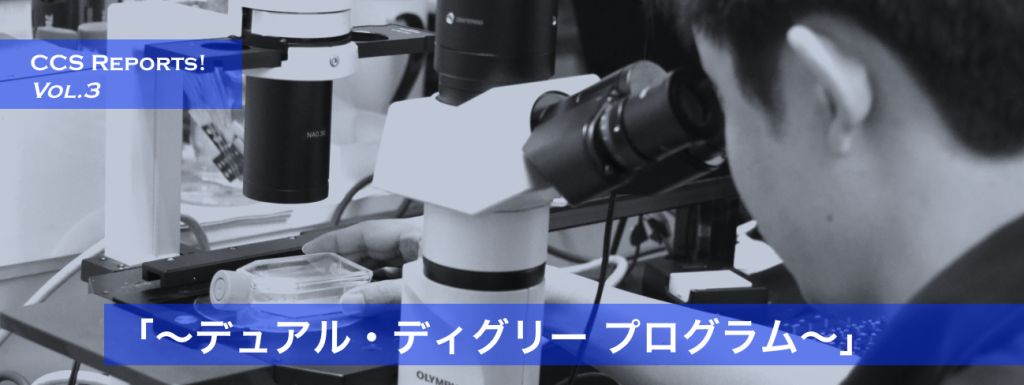 計算科学研究センターの取り組みを紹介する、CCS Reports! 第三弾。今回はCCSの人材育成の取り組みとして、デュアル・ディグリープログラム(DDプログラム)をご紹介します。現在DDプログラムに在籍する久米さんに、博士課程と修士課程それぞれの研究の内容や、両者を同時並行するプログラムの実態をインタビューします!(取材日:2016.12.27)
計算科学研究センターの取り組みを紹介する、CCS Reports! 第三弾。今回はCCSの人材育成の取り組みとして、デュアル・ディグリープログラム(DDプログラム)をご紹介します。現在DDプログラムに在籍する久米さんに、博士課程と修士課程それぞれの研究の内容や、両者を同時並行するプログラムの実態をインタビューします!(取材日:2016.12.27)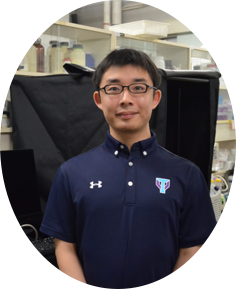
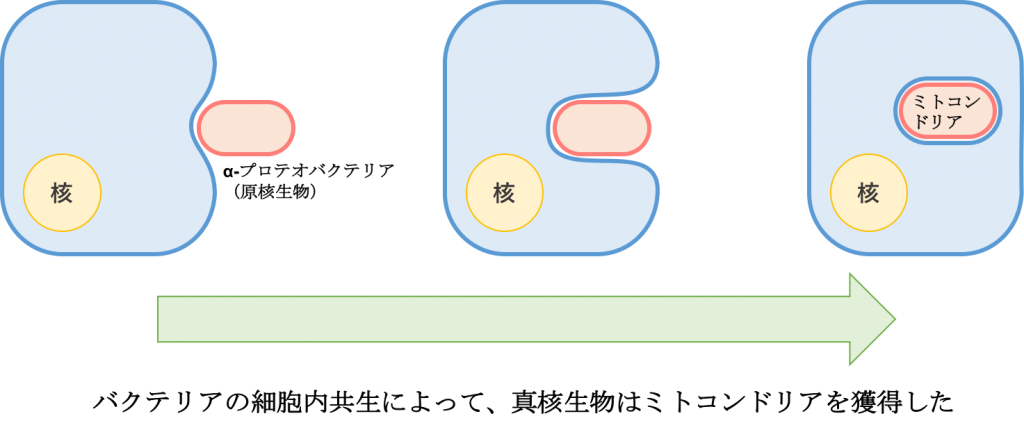

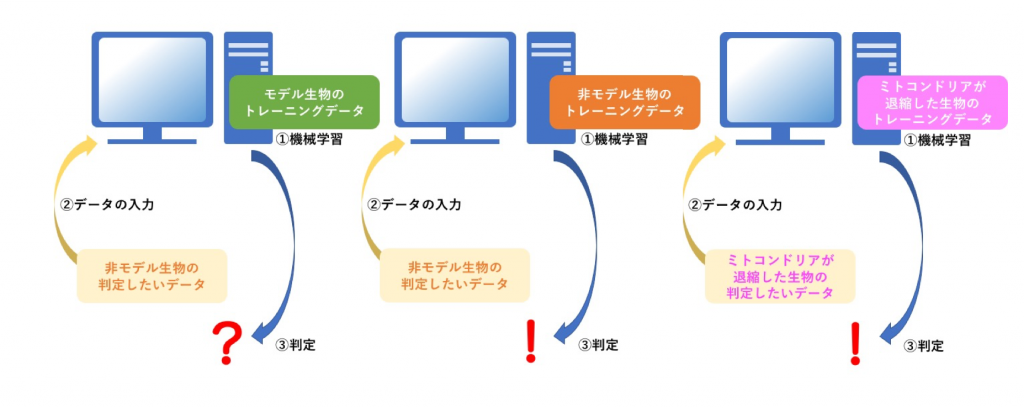
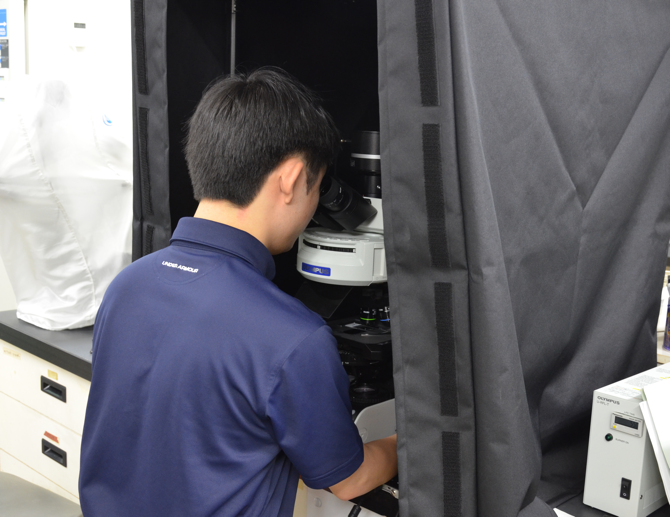

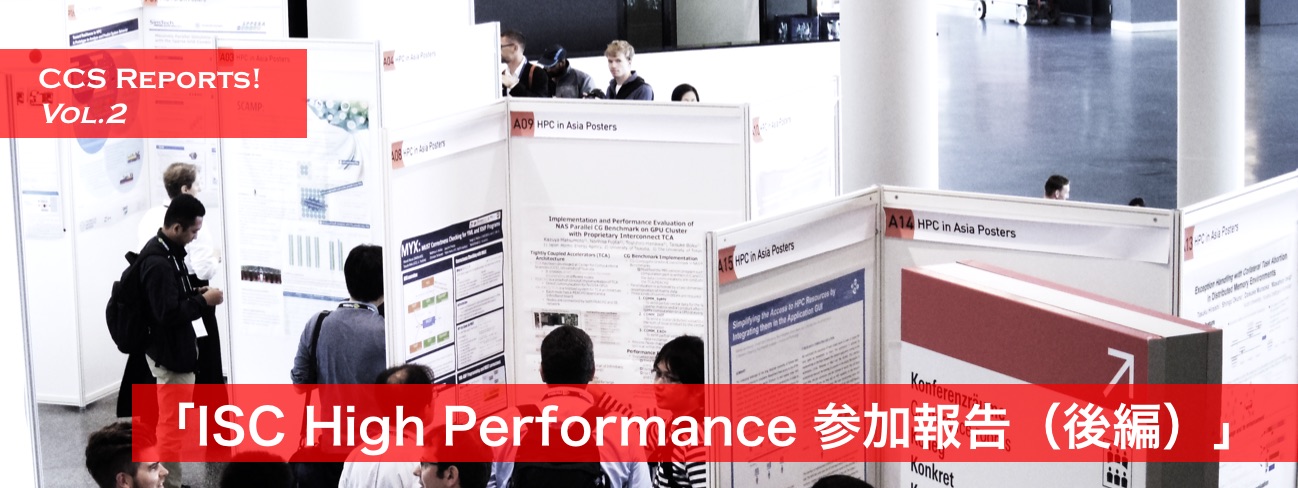 CCS Reports! 第二弾の後編は、ドイツ・フランクフルトで開催されたISC High Performance(2016年6月19日〜23日)の中の1セッション、HPC in Asia (ハイパフォーマンス・コンピューティング in アジア)にて、ポスター発表を行ったお二人の研究内容を紹介します。それぞれ、CCSで実際に動いている2台のスーパーコンピュータ、HA-PACS/TCAとCOMAに関する研究です。さっそく、スパコン研究の世界を覗いてみましょう! (2016.7.19)
CCS Reports! 第二弾の後編は、ドイツ・フランクフルトで開催されたISC High Performance(2016年6月19日〜23日)の中の1セッション、HPC in Asia (ハイパフォーマンス・コンピューティング in アジア)にて、ポスター発表を行ったお二人の研究内容を紹介します。それぞれ、CCSで実際に動いている2台のスーパーコンピュータ、HA-PACS/TCAとCOMAに関する研究です。さっそく、スパコン研究の世界を覗いてみましょう! (2016.7.19)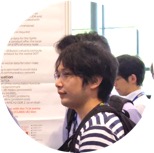
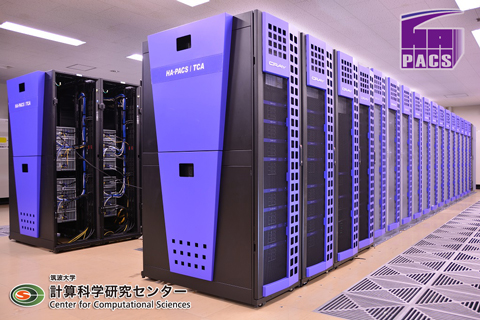 [HA-PACS/TCA]
[HA-PACS/TCA]
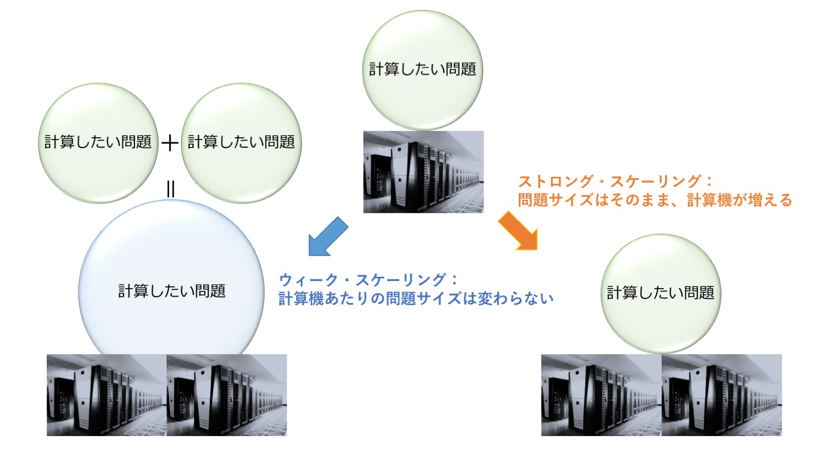
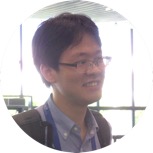
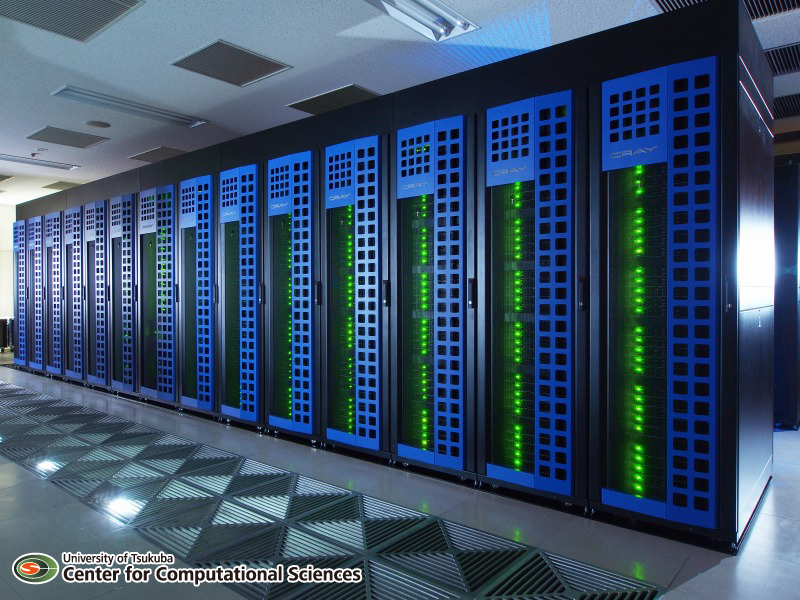
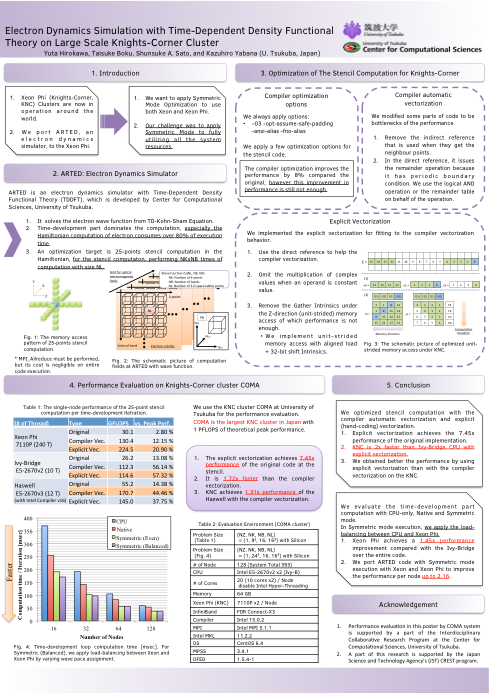
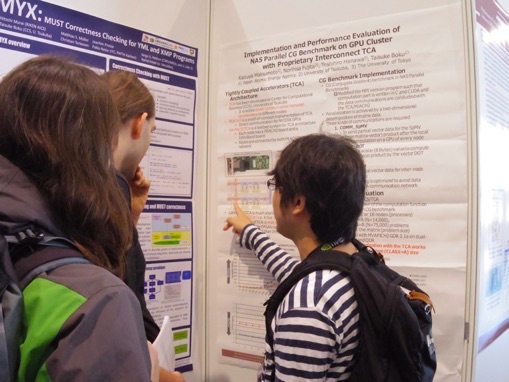
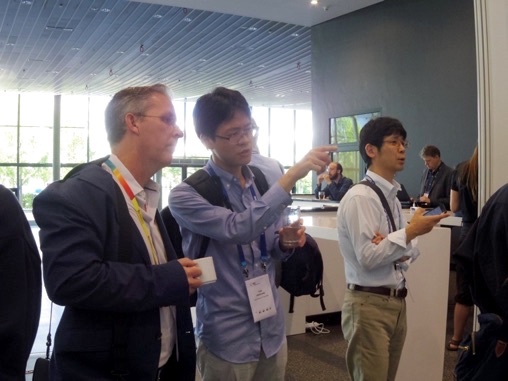
 計算科学研究センターの取り組みを紹介する、CCS Reports! 第二弾。今回は、2016年6月19日〜23日にかけて、ドイツ・フランクフルトで開催されたISC High Performance の様子をレポートします。今年12月稼働予定のスーパーコンピュータについてもちょこっとご紹介。後編では、ポスター発表を行ったお二人の研究ミニインタビューもあります!(後編:もうしばらくお待ちください) (2016.7.7)
計算科学研究センターの取り組みを紹介する、CCS Reports! 第二弾。今回は、2016年6月19日〜23日にかけて、ドイツ・フランクフルトで開催されたISC High Performance の様子をレポートします。今年12月稼働予定のスーパーコンピュータについてもちょこっとご紹介。後編では、ポスター発表を行ったお二人の研究ミニインタビューもあります!(後編:もうしばらくお待ちください) (2016.7.7)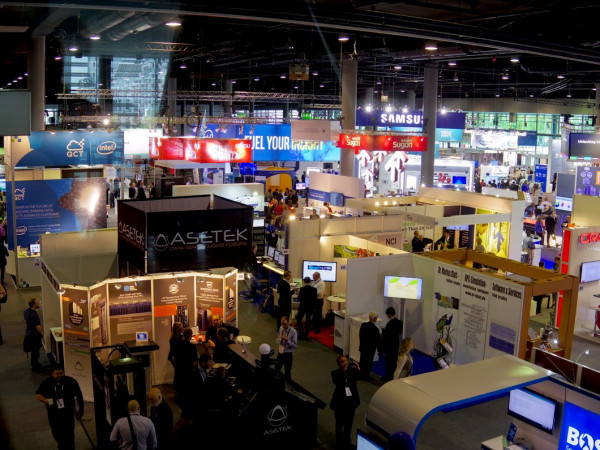 [写真:ISCエキシビション会場]
[写真:ISCエキシビション会場] [写真:JCAHPCのブースの様子]
[写真:JCAHPCのブースの様子]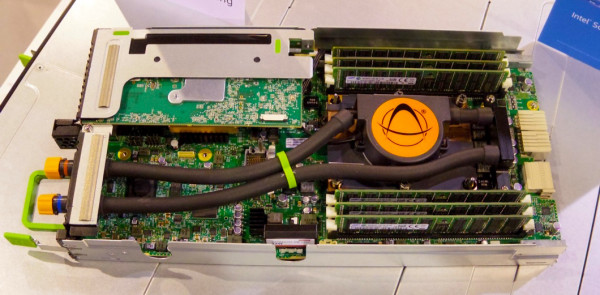 [写真:OFPのノード]
[写真:OFPのノード] [写真:情報解禁後に追加で貼られたデータ。あとから貼ってありますが、印刷ミスではありません!]
[写真:情報解禁後に追加で貼られたデータ。あとから貼ってありますが、印刷ミスではありません!]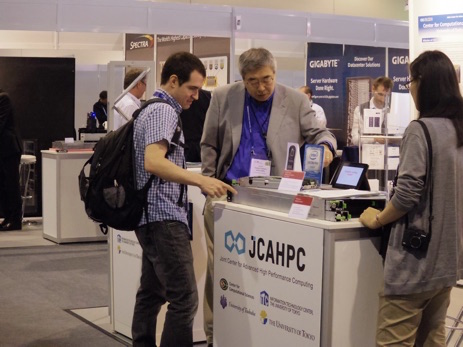
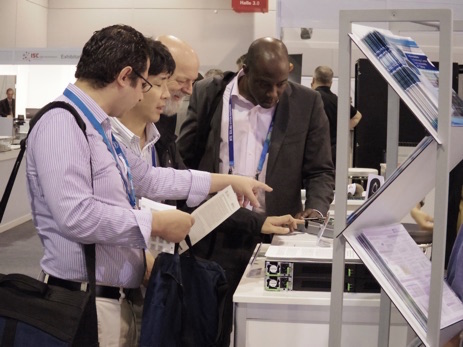
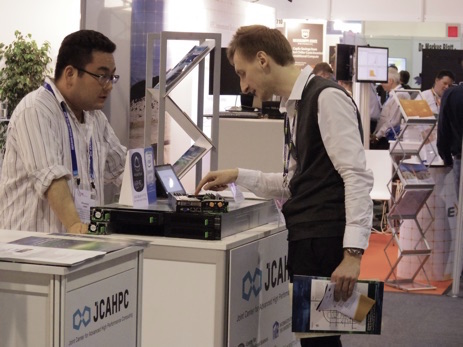
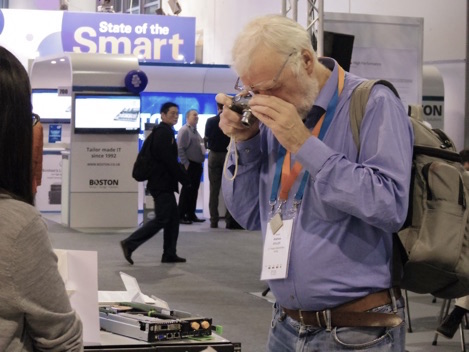 [様々な国の研究者や企業関係者が、OFPの詳しい説明を聞くために足を止めます。]
[様々な国の研究者や企業関係者が、OFPの詳しい説明を聞くために足を止めます。]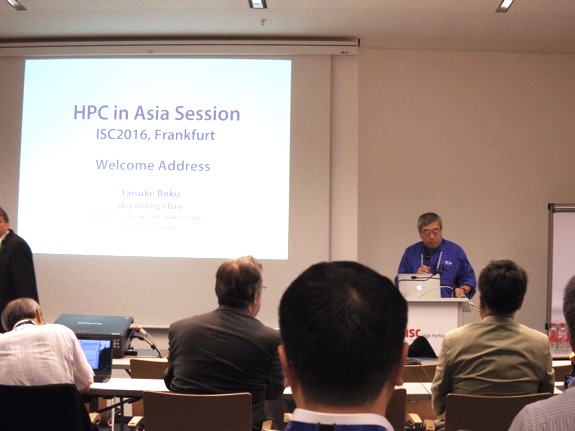 [写真:開会の挨拶をする朴教授]
[写真:開会の挨拶をする朴教授]